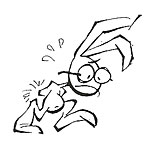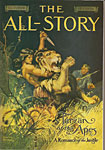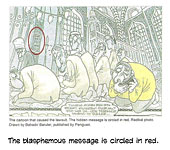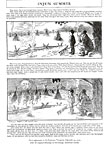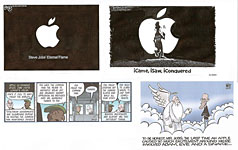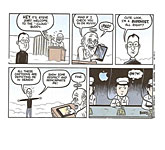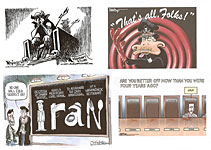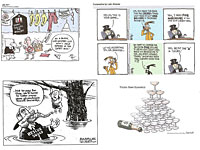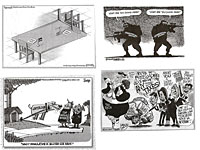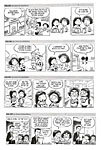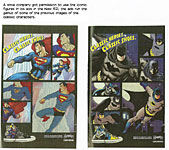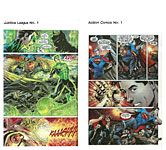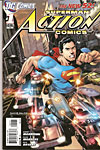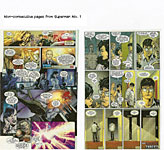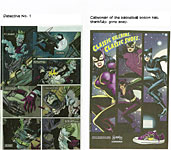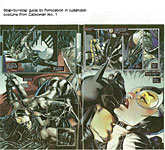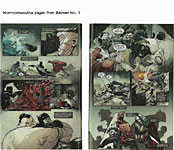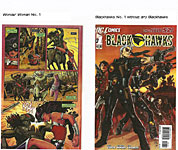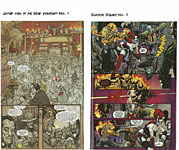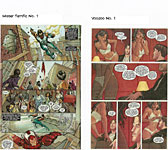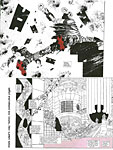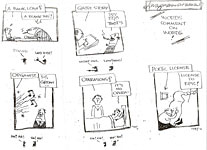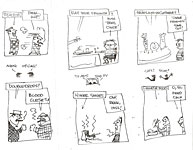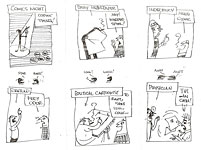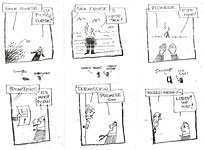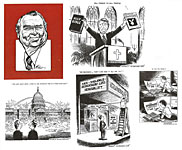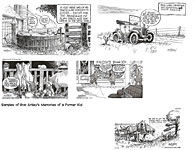 |
||||||||||||||||||||
Opus 285 (October 31, 2011). Yes, it’s still
the Year of the Rabbit, although, as you can plainly see, he’s sweating the
approach (in two-three months) of the end of his lunar year. The Big Events of this posting include reviews of 13 of DC’s New 52 (concluding, not surprisingly, that all the sex and violence means DC is aiming for an older audience—at least adults in the mid-stages of arrested development) and Frank Miller’s controversial Holy Terror, with a passing glance at The New Yorker’s so-called Cartoon Issue and a smattering of editorial cartoons from the last month, plus news and gossip galore. Here’s what’s here, in order, by department:
NOUS R US Dick Tracy’s 80th Boom’s Decision 2012 Marvel Layoffs? Name-Dropping & Tale-Bearing New Yorker’s So-called Cartoon Issue Tablet Wars: DC vs B&N CBLDF Gets Seal of Approval Tarzan’s Back Turkish ’Tooner on Trial
EDITOONERY Indian Summer Steve Jobs & Khadafy and More from the Month of October
Newspaper Comics Page Vigil Baldo and Illegal Immigration
THE BIG NEW FIVE-TWO Reviews of 13 of DC’s New 52: Justice League, Action, Superman, Batman, Detective, Catwoman, Batgirl, Wonder Woman, Blackhawks, All Star Western (Jonah Hex), Suicide Squad, Mister Terrific, Voodoo Plus Plans to Revive (Again) Captain Marvel
Graphic Novel Frank Miller’s Holy Terror
Jim Ivey’s AnagramOrama
PASSIN’ THROUGH Charles Brooks Bob Artley
Our Motto: It takes all kinds. Live and let live. Wear glasses if you need ’em. But it’s hard to live by this axiom in the Age of Tea Baggers, so we’ve added another motto:.
Seven days without comics makes one weak.
And our customary reminder: don’t forget to activate the “Bathroom Button” by clicking on the “print friendly version” so you can print off a copy of just this installment for reading later, at your leisure while enthroned. Without further adieu, then, here we go—
NOUS R US Some of All the News That Gives Us Fits
Dick Tracy passed the 80th anniversary of its launch date on October 12. The bloodiest strip of its day, creator Chester Gould had the titular character kill his first miscreant on November 26, just a little over a month after the curtain went up. The victim was a thug named Crutch who had killed the father of Tess Trueheart, Tracy’s betrothed, during a robbery on the very evening Tracy had popped the question, saying he hadn’t had any breaks “as far as money is concerned,” but with Tess at his side, he vowed to “find a way.” The date of the strip’s second killing—Tracy’s gunning down Crutch—was a holiday that Tracy, standing over the body of the man who’d murdered his fiancee’s father, observed by saying it wasn’t a bad Thanksgiving. The strip’s current proprietors, artist Joe Stanton and writer Mike Curtis, celebrated the anniversary month by re-enacting the strip’s first sequence—but with a few significant differences. Their frame story is Tracy’s cohort Sam Catchem telling policewoman Lizz how Tracy joined the detective squad. Tracy, it seems, was not out-of-work (as he implies in the original sequence) when he proposed to Tess: he was a uniformed cop on the beat. In the inaugural sequence of 1931, police chief Brandon, knowing the young man wants to avenge the death of his would-be father-in-law, invites him, implausibly, to join the plainclothes force right out of civilian life. In last month’s encore story, Brandon promotes the street cop in order to enlist both his passion for catching the murderer and his proven ability. And in the new version, Tracy is not only already a cop: he’s also a Navy veteran. Altogether, a much more plausible scenario. Most of the tale unfolds in its historic pattern except that the hoodlum population of Chicago consists of an inordinately high number of personages familiar to long-time readers (and recent fans) of Gould’s pace-setting strip, a veritable roll call of Gould’s grotesques from future Tracy escapades. The robbery that results in Mr. Trueheart’s death is conducted by members of a gang headed by Big Boy (an allusion to Al Capone), who was Tracy’s first arch-foe. Ribs Mocco and Crutch, who were both involved in the original robbery and the kidnapping of Tess, are still on the loose. But the rest of the gang putting in cameo appearances includes such classic reprobates as Flattop, Blowtop (who, Flattop suggests, is a member of the “Top” family?), Pruneface, the Brow, Mole, Gravel Gertie, 88 Keyes, Itchy, and Shaky, plus Steve the Tramp and the kid who will henceforth be known as “Junior.” In
all, a thoroughly enjoyable trip down memory lane and a notable way to
REPUBLICAN PRESIDENTIAL RACE TO END IN NOVEMBER Even Bill O’Reilly is bored by the bloviation of the GOP contenders. “There are going to be thirteen more of these debates,” he grimmaced regretfully into the Factor camera the day after the New Hampshire showdown. “But you don’t have to watch them,” he continued with one of his notorious self-satisfied grins, “—I’ll watch ’em for you.” Fortunately, none of us—including the avuncular O’Reilly—will need to pay any attention much longer. In a week or so, Boom Studios will announce the results of its “straw poll.” Concocted as a promotional stunt, Boom’s “Decision 2012" flogs its biographical comic book series, one title for each of nine Republican hopefuls—including Sarah the Palin—plus Obama. “The decision is in readers’ hands,” saith the press release, “—it’s up to them and their orders to see who wins!” The print runs for each title will be determined by orders placed in August. Total print runs will be announced in November, “and the candidate with the highest print run wins!” Chances are good that Pecos Perry will win: the “polls” closed before he appeared at any of the debates and destroyed his credibility by opening his mouth and saying something. At the time everyone was “voting,” he was still the newly heralded savior of the Grandstanding Obstructionist Pachyderm. Boom’s publicity touted the “once-in-a-lifetime” collectiblity of the books as well as the opportunity the stunt provided for participating in a historic event—the first ever comic book straw poll. Boom’s marketing mogul Chip Mosher is quoted in Comic Shop News where he stressed the “non-partisan” neutrality of the books while admitting out of the other side of his mouth that adherents of the candidates would like what they will find in the books. Each title, in other words, promotes its candidate and reports nothing to that candidate’s disadvantage. With so many cartoon characters running in the GOP race, it seems wonderfully appropriate that the outcome will be determined by comic books and their fans. A tentative irony hovers over the enterprise. Despite the emergence lately of graphic novels and big budget movies which give to comic books a certain cultural cachet, comic books still carry the stigma laminated on the medium by an earlier generation: anything deemed comic-booky is somehow juvenile and simple-minded. And that, I hasten to say, is a perfect characterization of the American political system as it has been conducted the last several cycles: campaigns have devolved into name-calling and the propagation of outright falsehoods. Actual issues and policy matters are left twitching in their death throes alongside the campaign trail. Moreso with the current crop of GOP candidates than at any other previous time. Rachel Maddow sees these elephantine aspirants as living in “Republicanland,” a place where all of the issues being discussed are fake. The debates are being conducted on the basis of “truths” that are not “factual.” The candidates nonetheless accept the falsehoods as facts because they are Republicans. They all agree that Ben Bernanke is the most inflationary chairman of the Federal Reserve in the history of the institution. And yet inflation under Bernanke is noticeably lower than it has been since the 1980s, when it was running at about 14%. Pecos Perry drew resounding applause when he asserted, without quibble or cavil, that the Obama Stimulus created “zero jobs” when, in the actual world, it probably created somewhere between 1.0 million and 2.9 million jobs according to most economists. Perry says Social Security is an abject failure and yet it is apparently working as designed for millions of retired Americans. And yet—all the GOP candidates talk of these easily disproved “facts” as if they were real. They’re all living in a fantasy—Republicanland—where Bernanke stokes inflation, the Obama stimulus created no jobs, and Social Security is a failure. A comic book country. And the Boom Studio straw poll validates it as a funnybook culture. Boom reports that any comic book that is ordered by fewer than 1,500 readers will not be published. Would that we could apply the a kindred rule to political candidacies throughout this heppy heppy land.
FLASH!!! FLASH!!!!! FLASH!!!!!! Boom Studios couldn’t wait until November. Once the orders were in for the Decision 2012 funnybooks, Boom blurted out the results of the “straw poll.” On October 6, a press release announced that Barack Obama had won, beating the entire GOP line-up. Among the Republicans, Sara Palin finished first, followed by Ron Paul and then Michele Bachman—cartoon characters all. None of the rest of the titles received the requisite 1,500 orders so books will not be published for (in the order of their finish in the poll) Mitt Romney, Herman Cain, Newt Gingrich, Jon Huntsman, Rick Santorum, and Rick Perry. As noted (painfully, now) above, I expected Pecos Perry to finish at the top of the heap because when the orders were being placed, he was just entering the race and hadn’t proved himself as dumb as a cinder block yet—that is, he hadn’t participated in a debate. But even before the first of these debacles, canny comic book fans apparently could tell he was too vacant -minded to run and voted him into last place. Bravo.
TROUBLE AT MARVEL? From ICv2.com: Marvel has declined to comment on reports circulating on October 21 (most notably, and first, on CBR) that as many as 15 employees in editorial and production roles are being laid off. At least one editor, Alejandro Arbona, has obliquely confirmed his layoff on Twitter. The layoffs follow the departure of Chief Operating Officer Jim Sokolowski, who was laid off a couple of weeks ago in a cost-cutting move. The rumors coming out of Marvel at New York Comic Con (October 13-16) were bleak, and included a reduced number of exclusive contracts for creators in the future (Andy Diggle has since revealed that he’s no longer under exclusive with Marvel), declining freelancer rates, projects that had been planned but were now being eliminated, and a general belt-tightening.
NAME-DROPPING AND TALE-BEARING Stan Lee’s POW! Entertainment and 1821 Comics introduced Romeo and Juliet: The War at the New York Comic Con (Scoop). ... Art and illustrated book publisher Abrams has signed a letter of intent to purchase SelfMadeHero, the London-based graphic novel publisher of such titles as Johnny Cash: I See A Darkness, already available in the U.S. Following completion of the deal, Abrams will launch a SelfMadeHero North American list beginning in 2012 (PublishersWeekly.com). ... For the first time, a graphic novel, Radioactive: Marie & Pierre Curie, A Tale of Love and Fallout by Lauren Redniss, has been nominated as a nonfiction finalist for the US National Book Awards, announced on October 12. An excerpt can be viewed on the author's website, laurenredniss.com (RelaxNews). From DailyCartoonist: The Miami Herald has bucked the trend of cutting comics and has [increased its comics line-up by] four. In all, seven new strips were added. Three comics (For Better or For Worse, Barney and Clyde, and Shortcuts) were dropped. The new comics starting in both the daily and Sunday pages are Cul-de-Sac and The Argyle Sweater. The rest of the seven new comics were added to the daily line-up: Get Fuzzy, Luann, Rhymes With Orange, Dustin, and Defrocked. The DailyCartoonist.com reports that at the Library of Congress an exhibit that opened September 15, “The Timely and Timeless,” includes several cartoonists— James Gillray and Honoré Daumier, as well as modern and contemporary creators such as Jazz Age cartoonist John Held, Jr., African American artist Oliver Wendell Harrington, New Yorker cartoonists Charles Addams and Roz Chast; and comic-strip creators Bill Griffith and Aaron McGruder and Jan Eliot, who wrote about the selection of her work from very early in her career with Stone Soup: “Looking back at the early work, despite the awkward drawings, I love the ideas I pursued, and my willingness to be bold since I had little to lose when I only had one, rather liberal, newspaper. This strip was written when I was still doing just one strip a week (Universal used the best from that period, plus new work, to put together the first 6 weeks of strips for my launch). Once syndicated, it’s possible to feel intimidated by public opinion, be terrified of losing a paper, and these fears might lead a cartoonist to be overly cautious in what they produce—and that would be unfortunate. Unlike Web cartoonists, who have a lot of editorial freedom, and no real editors, we newspaper cartoonists reside in, and sometimes bristle against, a rather conservative landscape.”
CARTOONS CELEBRATED, NOT It’s that time of year again: time for The New Yorker’s annual Cartoon Issue, which has arrived, bearing the same half-hearted tribute as in previous years. The first such effort appeared in 1997, and it was a whole-hearted tribute: in addition to publishing a special “cartoon section,” the magazine included a couple of text pieces about cartooning. That practice, which genuinely glorified the arts and crafts of the medium, was never again repeated. Subsequent Cartoon Issues contained only a dollop or two more cartoons than usual but no articles about cartooning or cartoonists. Hence, my verdict that the Cartoon Issue is a half-hearted tribute. And this year is a repeat performance. Apart from an 18-page section entitled “The Funnies” (which title is, itself, a sort of back-handed way of describing the magazine’s cartoons, “the funnies” being a term often used in reference to the “children’s” pages of a newspaper), the Cartoon Issue contains nothing else of pertinence to the practitioners or their artistry. And the editors could have done timely articles on either (or both) of (at least) two cartooning current events. Steven Spielberg’s Tintin movie has just opened in Europe and will open here in December. Tintin’s creator, the authentically world-famous cartooner Herge, has be reviled lately for his supposed racism and his equally imaginary Nazism. A refutation of both slurs could have been launched in connection with a review of the “performance-capture” movie. But, no—not at the super-sophisticated New Yorker. (Here at Rancid Raves, however, we’re not too stuck up to come to the defense of one of cartooning’s masters; next time, in Opus 286, we’ll undertake the mission. And we’ll report on the movie’s reception in Europe, too—particularly in Belgium, where Herge is a national hero.) Or The New Yorker could have reviewed “Infinite Jest: Caricature and Satire from Leonardo to Levine,” an exhibit currently at the Metropolitan Museum of Art. An article could have examined the careers of such vintage caricaturists as James Gillray or Thomas Rowlandson or Honore-Victorin Daumier, all of whom are present in the show with more than one picture. But, no—not at The New Yorker, which, founded on the principle that super sophisticates deserve regular ribbing, deserves a little jostling itself. Whatever else I might be tempted to say about the so-called Cartoon Issue I’ve said before on previous manifestations of the tribute—say, at Opus 270 or Opus 250. You can read those again and become attuned to my typical screed, which I could (but won’t) repeat (again) here. Here, I can add only a couple of observations peculiar to this year’s fiasco. First, the magazine commits the ultimate expression of contempt for a visual artform by printing several cartoons across the gutter of the magazine, thereby obscuring part of the art, desecrating it. How many is “several”? Five—five out of fourteen, or 36% of the single-panel cartoons in “The Funnies” section. How better to spurn an artform held in low esteem than to distort or disfigure it in public? In short, “The Funnies” section includes a substantial gesture of disdain for the medium this issue is supposed to be honoring. Second, half of the allotted pages are devoted to “comic strips” or cartoon vignettes in which pictures are accompanied by sarcastic or insightful text. Roz Chast is the champion of this kind of cartooning, and she gets two pages in which she re-visits scenes from her vacation in Utah and Colorado. One of them depicts a barren desert floor with a single cloud hovering over it; it’s captioned: “Emptiness, Utah.” You need the picture in order to discern any comedy in this array, but the affrontery committed by Zachary Kanin needs no pictures. Entitled “Breaking News 2012,” his comic strip consists of a series of “forecasts” of events of the coming year. Here are a couple: “The sea levels rise by five feet, but, in a dramatic turn of events, the land level rises by fifty feet.” “Six-pack abs fall out of fashion—the new big thing in 2012 is having four butts.” “The ‘missing link’ is finally discovered—surprisingly, it is a starfish with human breasts.” Funny enough, no doubt, but Kanin’s pictures add nothing to the hilarity. So why is his effusion included in the Cartoon Issue? The readers of The New Yorker dote on the cartoons, and the cartoons are first among the magazine’s contents that have elevated the periodical above all its fellows on the newsstand and throughout popular culture. The editors, however, don’t seem to share in the appreciation. They are all—with the exception of the art director and the cartoon editor—wordsmiths, not artsmiths. They probably don’t understand cartoons. It’s not surprising, then, that the Cartoon Issue has been such a lurching failure for 14 of its 15 incarnations. You might be persuaded from the haphazard treatment that The New Yorker is trying its best to ignore the cartoons it’s pretending to glorify. And I suspect that’s exactly the case. The first Cartoon Issue was dated December 15, as if it were conceived as a Christmas present for readers. In subsequent years, the Cartoon Issue has retreated, slowly, away from late December into late November. And then into early November. This year, it’s dated October 31. This is an insidious ploy: by moving the Cartoon Issue back in the calendar a little each year, you eventually can claim that last year’s Cartoon Issue is actually this year’s and thereby avoid publishing one of the things altogether. That’s how the magazine will eventually escape for at least one year performing a duty that it has evidently found odious. It is to weep.
TABLET WARS In a move seen as retaliation against DC Comics’ deal with Amazon giving its new Kindle Fire a four-month exclusive on digital versions of 100 DC graphic novels (including perennial bestseller Watchmen), Barnes & Noble, the world’s largest bookseller, is removing those 100 DC bestselling backlist titles from its 705 retail stores in the U.S. Books-a-Million, which operates 211 stores in 23 states, followed suit almost immediately, reported ICv2.com. Barnes and Noble maintains that it won’t sell any versions of the popular graphic novels if they weren't allowed to sell the digital versions as well, reported Molly Driscoll at csmonitor.com. (The print versions of the novels will still be offered through the Barnes & Noble website as well as available for special order at any B&N bookstore). "Our policy is that we won't stock physical books in our stores unless we're offered the content in all formats," Jaime Carey, B&N’s chief merchant, told the Wall Street Journal. "We want to maintain a premiere customer experience." But there’s a little more to the story. DC’s Amazon maneuver made its digital editions off-limits to Barnes & Noble’s Nook e-reader, which is being introduced this month, and Amazon priced some of the Kindle Fire books at $9.99, half the price of the print editions. In effect, DC seriously undermined the competitive environment. In a press release, Books-a-Million CEO Terrance Finley said: “We will not promote titles in our stores’ showrooms if publishers choose to pursue these exclusive agreements that create an uneven playing field in the marketplace.” Quoth ICv2: “We haven’t heard what the term of the DC exclusive with the Kindle is, but there will be a window of at least some months, including the all-important holiday season, with vastly reduced availability of those titles in chain bookstores. This will offer an opportunity for all of B&N’s competitors, and will undoubtedly hurt DC’s graphic novel sales through the end of the year.”
COMIC BOOK LEGAL DEFENSE FUND GETS SEAL OF APPROVAL The Comic Book Legal Defense Fund, an organization that defends First Amendment rights for the comic industry, announced yesterday that it has inherited intellectual property rights to one of the most nefarious emblems of the Age of Censorship (self-censorship) in comics history— the Comics Code Authority Seal of Approval that was branded on the covers of all comic books that had passed the Authority’s inspection. "[The Seal] will now be associated with an organization protecting creativity as opposed to a force that stifled it," said Charles Brownstein, CBLDF executive director, who pointed out that this announcement [made on September 30] appropriately falls within Banned Books Week. "Anyone who's read a comic book in the last 60 years has had some superficial interaction with this icon, and to be able to harness it to raise awareness of the First Amendment and the dangers of censorship is a vastly good thing. "As the Comic Magazine Association of America was winding down they approached us to inquire whether we would be interested in receiving the Seal of Approval," Brownstein told Vaneta Rogers at Newsarama. "Through a brief, and fairly straightforward process, they assigned us the rights to the Seal for use as part of our fundraising and education program. It was a donation from industry's dying self-censorship body to assist its mature First Amendment defense body." The Comics Code Authority "stamp" of approval was established by the Comics Magazine Association of America in 1954 in response to a public outcry — including Congressional hearings — about violent and sexual content in comics. It was inspired, Rogers writes, in large part by Fredric Wertham's book Seduction of the Innocent, which claimed that reading comics led to juvenile delinquency. "The Code was created as a means for the industry to survive a vicious witch hunt whipped up by moral panic," Brownstein said. "It was a self-preservation measure that the industry took to fend off a mob mentality that could have driven it out of business." “So in a way,” said Rogers, “the self-regulating stamp saved comics from a certain death. But it also self-regulated comics in a way that encouraged only child-targeted material—creating an expectation of comics always being ‘kid stories,’ a perception that permeates society even today.” “Those days,” said Brownstein, referring to the years after the imposition of the Code, “are a brutal illustration of how creativity can be crushed by the forces of moral panic. ... The Comics Code was a compulsory measure administrated by an external body that publishers had to adhere to in order to obtain distribution.” CBDLF’s use of the Seal will help with fund-raising because it can now be licensed for use on items for sale, including a current t-shirt from Graphitti Designs that sports the Seal as logo. "Certainly there are other opportunities to license the Seal, and we'll be glad to work with folks who want to propose ways to help us raise money using it," Brownstein said. The CBDLF is hoping attention to their acquisition of the Seal will also raise awareness of its current "Be Counted" campaign. The organization is hoping to raise $100,000 by October 31st by encouraging comic readers to become members. Even after that date, it’s not too late to do your part. CBLDF membership starts at $25 per year, and comes with a variety of benefits, including a Green Lantern membership card and addition to a member list at www.cbldf.org. Donors who give more can also receive gifts of time and items from creators. Visit cbldf.org for details.
GOING APE ALL OVER AGAIN Tarzan is
returning to comic books after a sabbatical of several years—just in time to
celebrate next year the 100th anniversary of the character’s
inaugural appearance in All-Story magazine in October 1912. For Nelson, the intriguing aspect of Tarzan is that despite being raised in the jungle by apes, he wants to be part of the human world. “There’s always conflict between his animal instincts and his desire to be ‘civilized.’ For me, that’s what makes him tick.” The big challenge in adapting a 100-year-old creation is in finding ways to get around the racial stereotyping that prevailed in Burroughs’ world. But “modernizing” is not part of Nelson’s vision.
Turkish Cartoonist To Be Put On Trial for Renouncing God From Hurriyet Daily News. A Turkish cartoonist will be put on trial for a cartoon he drew in which he renounced God. The Istanbul chief public prosecutor's office charged cartoonist Bahadır Baruter with "insulting the religious values adopted by a part of the population" and requested his imprisonment for up to one year. In
a cartoon published in the weekly Penguen humor magazine, Baruter
depicts an imam and believers praying in a mosque. One of the characters is
talking to God on his cellphone and asking to be pardoned from the last part of
the prayer because he has errands to run. But the renunciation occurs on the
wall decoration of the mosque, where Baruter hid the words, "There is no
Allah; religion is a lie” (circled in red in the accompanying reprint of
Baruter’s cartoon). Turkish Religous Affairs and Foundation Members' Union and some citizens filed complaints against Baruter, and the public prosecutor's office accepted the complaints and filed a lawsuit against the cartoonist. That’s what life is like in a country the government of which is operated at the whim of the nation’s major religion. Keep it in mind the next time some aspirant for residence in our White House is criticized for not being religious enough. Or for adhering to the wrong religion.
Fascinating Footnit. Much of the news retailed in the foregoing segment is culled from articles eventually indexed at rpi.edu/~bulloj/comxbib.html, the Comics Research Bibliography, maintained by Michael Rhode and John Bullough, which covers comic books, comic strips, animation, caricature, cartoons, bandes dessinees and related topics. It also provides links to numerous other sites that delve deeply into cartooning topics. Three other sites laden with cartooning news and lore are Mark Evanier’s povonline.com, Alan Gardner’s DailyCartoonist.com, and Tom Spurgeon’s comicsreporter.com. And then there’s Mike Rhode’s ComicsDC blog, comicsdc.blogspot.com and Michael Cavna at voices.washingtonpost.com./comic-riffs . For delving into the history of our beloved medium, you can’t go wrong by visiting Allan Holtz’s strippersguide.blogspot.com, where Allan regularly posts rare findings from his forays into the vast reaches of newspaper microfilm files hither and yon.
Quotes and Mots “Silence is the language of the Almighty; all else is a poor translation.”—Jalal ad-Din Rumi “I opened a box of animal crackers but there was nothing inside. They’d eaten each other.”—Lily Tomlin “When those waiters ask me if I want some fresh ground pepper, I ask if they have any aged pepper.”—Andy Rooney “Ever wonder if illiterate people get the full effect of alphabet soup?”—John Mendoza
EDITOONERY Afflicting the Comfortable and Comforting the Afflicted
NOTE: Since we posted Opus 284, we’ve corrected an error therein. In the Editoonery paragraph beginning “We leave NineEleven behind,” one group of editorial cartoons being discussed was omitted as a visual aid; it has now been restored.
Indian Summer is the term we apply to the especially balmy stretch of days that often occur during the middle weeks of autumn. Here in Colorado, Indian Summer is one of the state’s most beautiful seasons when the aspen on the velvet pinetreed slopes turn a brilliant yellow and fleck the mountainsides with their gold. One
of the profession’s most famous cartoons celebrates Indian Summer: it appeared
on the front page of the Chicago Tribune on September 30, 1907. John
T. McCutcheon, who would be denominated the “dean of American editorial
cartooning” a half century later, was stuck for an idea and his deadline
loomed. And then, inspired by a string of beautiful warm autumn days and
remembering his youth in Indiana, he conjured up the illustration at hand and
wrote the accompanying text. As early as 1919, said Stephan Benzkofer recently at the Tribune (October 16), the “famous” cartoon had become a “much-loved” annual event, and the Trib produced a high-quality copy “ready for framing” for purchase by enamored readers. Indiana State Fair reproduced it as a feature exhibit in 1928. At the Century of Progress World’s Fair in 1933-34, it was a life-size diorama and was reproduced in a fireworks display. Neighborhood, school and social groups acted out “Injun Summer” scores of times—as recently, Benzkofer reports, as 1977. “One of the biggest dramatizations involved 1,100 school children performing it at Soldier Field in August 1941 as part of the Tribune-sponsored Chicagoland Music Festival. ... But over time, the cartoon came to evoke anger as well as nostalgia. As early as 1970, readers wrote letters complaining that the Tribune was running an ethnically insensitive feature that misrepresented the brutal reality of Native American history in the United States in the 18th and 19th centuries. Letter writers also were unhappy with the text claiming that ‘they ain’t no more left,’ pointing out that Indians still lived and worked in Chicago.” In the 1990s, the Trib’s editors decided to end the annual ritual, public editor Douglas Kneeland said: “‘Injun Summer’ is out of joint with its times. It is literally a museum piece, a relic of another age. The farther we get from 1907, the less meaning it has for the current generation.” I disagree. Some of the notions in the text accompanying the cartoon may be insensitive in our politically correct age, but the imagery—the stacks of corn stalks morphing into teepees in a kid’s imagination—is still full of meaning for anyone who has ever been a kid. No matter. “Injun Summer” with its insensitive corruption of the name of the group it invokes is gone. But not, apparently, forgotten. Said Benzkofer: “The cartoon has a powerful hold over many Chicagoans. For generations of readers, ‘Injun Summer,’ despite its flaws, became synonymous with the magic and peacefulness of those last warm days of the season. And just last week, the Tribune received another request to publish it.” Thanks be.
AND NOW, ON TO A CONTEMPORANEOUS autumn with a harvest of some editoons about the chief events of the last fortnight or so. (The last month, actually; I just like to use “fortnight” in a sentence.) Judging from the covers of numerous magazines on the stands over recent weeks, the death of Steve Jobs on October 5 was the most significant event of the season (if not the year—or, even, of our lifetime). His departure gave the nation’s editorial cartoonists a “snow day” on the 6th or 7th (depending upon newspaper’s deadlines). You could almost stay home and phone in a picture of Jobs at the Pearly Gates, teaching Saint Peter how to use an iPad. And many editooners drew just that. So did Barry Blitt on the cover of The New Yorker for October 17, showing the bearded old Saint with an iPad and Jobs looking on, entitling it “The Book of Life.” A few satiric penmen, however—fully aware of the highly probable likelihood that they would draw a cartoon that would be virtually the same as everyone else’s—managed a slightly different slant as we see in the adjacent culling.
Many of the cartoon eulogies deployed a sold black background and silhouetted against it the regnant Apple symbol. At the upper left, Pat Bagley was one of those few who managed a variant image by making part of the Apple the “eternal flame” to suggest Jobs’ impact upon the modern world. Going clockwise, Joe Heller produced another variation on the same visual, but added a caption that created another dimension (an idea repeated elswhere, too). Then Randy Bish used the Pearly Gates metaphor but supplied a novel app to the Apple. At the lower left—straying from the single-panel domain of most editoons—Darrin Bell in his strip Candorville undermined the eulogistic tenor of cartoon commemoration by reminding us all that Jobs’ messianic function did not include the sweatshop populations that produced Apple hardware. But Matt Bors ventured even further from the well-trod and threadbare as we see in his strip. Michael Cavna at ComicRiffs.com had noted that many editoonists in employing the Pearly Gates image apparently forgot that Jobs was a Buddist. Some cartoonists noted the oddity, too, “but one artist, Portland’s Matt Bors, has now rendered perhaps the most inspired response.” And Cavna goes on to annotate Bors’ strip: “With his cartoon, Bors deftly nails a satiric trifecta—lampooning the accumulated cumulus of Jobs cartoons that too easily invoked iClouds, iPads and the Christian imagery. And then, with a real beauty of a last panel, Bors mocks Apple’s own employment practices in China—ultimately tweaking even the pundits’ beatification of Jobs himself. Five panels. At least five satiric targets. Bors scores. How great his art.” Cavna goes on to quote Bors, whom he interviewed: “The cartoon struck a chord because it filled a void, left by my colleagues, for satire on Steve Jobs’ death. Anytime a figure is glorified the way Jobs was, there’s a backlash against it. People love to see the mighty brought down a peg, and there were legitimate reasons to criticize Jobs that were left unsaid after his death.” Cavna elaborates: “Bors also notes that his cartoon’s effectiveness was dependent on how many of his colleagues ‘went overboard’ with the Pearly Gates trope. ‘Many people think those [cartoons] are silly, so a self-aware comic mocking the convention was likely to be a hit.’ “Bors decided to wield both satire and meta-satire: ‘As an editorial cartoonist, I don’t consider any topic off limits for satire and criticism. That includes the recently departed—and editorial cartooning itself,’ he finished.” But Cavna wasn’t quite finished: he noted that California governor Jerry Brown declared Sunday, October 16, “Steve Jobs Day” in the left coast state.
WHATEVER HE WAS, STEVE JOBS was not an inventor. His biographer, Walter Isaacson, began his Jobs obit for Time by saying: “He didn’t invent many things outright, but he was a master at arranging ideas, art, and technology in ways that repeatedly invented the future. He designed the Mac after appreciating the power of graphic interfaces ... he created the iPod after grasping the joy of having a thousand songs in your pocket” in MP3. He was not an engineer. He was not a techie. Jobs was a tinkerer with the drive of a perfectionist and the instincts of a designer. At The New Yorker, James Surowiecki writes: “Jobs’ defining quality was perfectionism. The development of the Macintosh, for instance, took more than three years because of Jobs’ obsession with detail. He nixed the idea of an internal fan because he thought it was noisy and clumsy. And he wanted his engineers to redesign the Mac’s motherboard just because it looked inelegant. At NeXT, the company he started after being nudged out of Apple in 1985, he drove his hardware team crazy in order to make a computer that was a sleek, gorgeous magnesium cube. After his return to Apple in 1997, he got personally involved with things like how many screws there were in a laptop case. It took six months until he was happy with the way that scroll bars in OSX worked.” According to Isaacson, Jobs thought of himself as an artist. His passion was what he called “the whole widget”—the machinery, the software, everything had to be integrated into a user friendly (and physically attractive) package. And that passion resulted in gadgets that people wanted even though they didn’t need them. He was more P.T. Barnum than Thomas Edison said Jim Picht at WashingtonTimes.com. He sold us a new future. Nudging and cajoling (and often berating) the people who worked for him, Jobs revolutionized six industries: personal computers, music, phones, tablet computing, digital publishing, and animated movies. Although Jobs was by no means an animation professional, he enabled the most spectacular advance in animation in the last 50 years when he purchased Pixar from Lucasfilm in 1986 and put both his money and support behind it. “In the beginning, Pixar was a hardware store [for Jobs],” said Tom Sito, a Disney veteran. “But Steve was won over to the idea of making animated film by the successful short films that Pixar and John Lasseter were making” (like “Luxo Jr.” and “Tin Toy”). Said Jen Chaney at the Washington Post: “Company pioneers like John Lasseter and Andrew Stanton, as well as other creative storytellers and animators at Pixar, would ultimately be responsible for making those movies. But what is true for them is true for virtually anyone who has permission to be inventive in any field: they could not have achieved greatness without the finances that gave them the freedom to do it.” In his book, The Pixar Touch, David Price explains that it was Pixar, not Apple, that would ultimately make Jobs a billionaire.
INCIDENTALLY, Dennis M. Ritchie died on October 12, just a week after Jobs. We didn’t hear much about him, but he did more for modern computing than sell snazzy products. At Bell Labs, Ritchie, with Brian Kernighan, developed the C programming language, a versatile and portable language used for everything from embedded systems to graphic software; and with Ken Thompson, Ritchie developed the Unix operating system, which inspired the OS X system on the Mac. “In other words,” writes Denver Post columnist Ed Quillen, “just about anywhere you look in the digital environment, you’ll find some connection to Dennis Ritchie’s C and Unix.” But Steve Jobs’ death grabbed all the headlines. As he was accustomed to doing..
THE OTHER PRINCIPAL EVENT of recent weeks was the grab-ass slaying of Khadafy in Libya, and our concluding array of editoons begins with Milt Priggee’s celebration of that event.
Many of the cartoons on Khadafy’s death had the legendary nutcase tyrant of the Middle East in Hell, where he receives an assortment of comeuppances. Priggee, however, produced a striking detour from the easy route taken by so many of his colleagues: as we see at the upper left of our first exhibit, his cartoon evokes Bill Mauldin’s classic image at the death of John F. Kennedy, the sorrowful statue at the Lincoln Memorial. But Priggee’s smitten statue is of the Devil himself, mourning the loss of his most important missionary on Earth. Nice turn. Next on the clock is Bill Day’s reminder that Khadafy was nuts—er, daffy—employing an image familiar to movie-goers worldwide. R.J. Matson took of in another direction, presenting Khadafy’s death as a premonition for Syria’s Assad. With the last imagery in this quartet, Joe Heller shifts to a different subject—the supposed Iranian plot to assassinate the Saudi Arabian ambassador to the U.S. This one becomes a little farfetched if you attempt to assign actual correspondences to the images on the blackboard; too much of a stretch maybe. But the overall image is effective in conveying the idea that the evidence of Iran’s guilt is pretty obvious. With the next collection, we move to the broader if more disgraceful arena of American politics. At the upper left, Joel Pett’s image is of dirty laundry hanging on the line. He may not have intended precisely that interpretation, but I see it that way. Pett likely began with the concept of a “laundry list,” which he then hung out to dry. For all to see. And what we see is the same old boring GOP program once again. Well, maybe “dirty laundry” does apply. None of these “initiatives” worked the last time they were tried, so they’re used and therefore “dirty” like a previously worn and now smelly sock. (And that leads us to trot out the bromide that people who try the same things over and over, expecting different results every time, are demonstratively insane.) (And yet a vast number of tea lovers in this country advocate doing precisely that.) I applaud the revelation in Mitch McConnell’s utterance, but that, like the one leg amputated on Uncle Sam’s trousers, doesn’t seem integral to the over-all metaphor. McConnell’s speech is, however, the chief reason I picked this cartoon. A propos the GOP laundry list, our financial predicament and the plan espoused by McConnell and his minions, and the attitude of the entire slate of Republican prez candidates, here’s E.J. Dionne Jr. at the Washington Post: “So let’s see: the solution to large-scale abuses of the financial system, a breakdown of the private sector, extreme economic inequality and the failure of companies and individuals to invest and create jobs is—well, to give even more money and power to very wealthy people, to disable government and to trust those who got us into the mess to get us out of it. That’s a brief summary of the news from the Republican Party this week. It’s what Republican candidates said during the Washington Post-Bloomberg debate, and it’s the signal Senate Republicans sent in voting as a bloc against President Obama’s jobs bill. Don’t just do something, stand there. ... There’s no problem that can’t be solved if the federal government just does absolutely nothing about it.” Dionne concludes by explaining what Rep. Barney Frank meant with the concept of Reverse Houdinis: “They are people who tie themselves up in knots and then declare: ‘I can’t do anything because I’m all tied up in knots.’ We seem on the verge of putting Reverse Houdinis in charge of our government.” If they persist in this mode, they’ll inspire 99% of the population to occupy seats of power and government. Back to visual aids: next around the clock are a pair of La Cucaracha (“the cockroach”) comic strips by Lalo Alcaraz, who also produces an occasional editorial cartoon. But he, like Aaron McGruder before him, laminates his comic strip with political commentary. This is a straight-forward indisputable assault on the reasoning of banksters. No metaphors; no imagery. Just Cuco, the cockroach of the strip’s title, in sarcastic action. Again, I liked the message so much I saved the strips even though metaphor and imagery (except for the Monopoly character in the role of bankster) are not quite so active in conveying the message. Clay Bennett’s cartoon at the lower right, however, is rich in imagery. The champagne and the champagne glasses suggest wealthy imbibers of the product, the people who get to take their glasses from the top. They get all the champagne; none of it trickles down to the glasses at the bottom. And yet the glasses at the bottom are holding up the glasses at the top. Multiple meanings and a memorable image. Nicely done. Finally, we have Jimmy Margulies at the lower left. The metaphor is scarcely as complex as Bennett’s, but it conveys the message, and the image is undeniably persuasive and memorable—the Grandstanding Obstructionist Pachyderm’s attitude about funding emergency services would rob Peter to pay for Paul, leaving one or the other still in need of emergency services. In our last assemblage, we return to Bennett, whose metaphor for the peace talks between Israel and Palestine shows why it’s so hard to get the parties to the negotiating table. (I inadvertently added to the import of the image by scanning the cartoon upside down.) Next is Steve Benson’s telling imagery that reveals the hypocrisy of our national reaction to the Iranian plot to kill a Saudi ambassador on U.S. soil. Seems to me that we did something similar in Pakistan last spring. Bagley heaps up the sarcasm on the GOP positions on taxation. In his images, the Rich carry far less of a taxation load than little guys like you and me. And yet the insanely barking Republicans (Eric Cantor, Michele Bachman, Mitch McConnell, and Paul Ryan) choose to vilify us for paying less in taxes (even though, considering sales taxes and payroll taxes, we are paying a goodly portion). The hilarious hysteria of the scene makes it memorable. And Bagley’s seemingly tossed-off caricatures are deadly accurate. We don’t see much of Lee Judge around the country. I’m not sure who syndicates him. But his drawings at the Kansas City Star are crisply modern, and here, at the lower left, we can see that an unrestrained mad dog (“capitalism”) would tear the throat out of the average American worker. True, as far as it goes. But the rest of the metaphor would have the dog chewing himself up. The inherent flaw in capitalism is not so much that it makes victims and slaves of everyone at the bottom of the economic heap (although that’s an apparently inherent evil) but that it will destroy itself, too—in the greedy fulfillment of its own natural inclinations.
PERSIFLAGE AND FURBELOWS Here’s one that drifted in over the Internet transom: The English language has some wonderful collective nouns for the various groups of animals. For example, we are all familiar with a herd of cows, a flock of chickens, a school of fish, and a gaggle of geese. Lesser known words are a pride of lions, a murder of crows, an exaltation of larks, and a muster of storks. Now consider a group of baboons. They are the loudest, most dangerous, destructive, obnoxious, viciously aggressive and unintelligent of all primates. And what is the appropriate noun for a group of baboons? Believe it or not— a congress! Not quite. A bunch of baboons is not a congress; it’s a rumpus. Which goes to show you: don’t rely on the Web for accurate information.
*****
“I believe that at some level when you get elected President, they take you into a room and there are five guys sitting there you’ve never met before, and they open up a book and go, ‘Here’s what’s really going on.’ And that’s when your hair first turns white. You walk out of that room like, ‘Holy fuck!’ So at some level, I have a great deal of sympathy for ‘heavy is the head that wears the crown.’ I don’t necessarily have a good Chicken Soup for the Soul piece of wisdom for him [Obama].”—Jon Stewart
GOSSIP & GARRULITIES Name-Dropping & Tale-Bearing Here’s a treat: on YouTube there are some "Tau au Tac" shows that have Giraud, Hugo Pratt and Steranko drawing live. It’s fascinating to watch them thinking visually:
www.youtube.com/watch?v=do-cvwBKfw8&noredirect=1
It’s a particular joy to watch Pratt as he draws Corto Maltese behind the lettering across the top of the panel.
NEWSPAPER COMICS PAGE VIGIL The Bump and Grind of Daily Stripping Baldo, Hector Cantu and Carlos Castellanos’
comic strip about a Latino family with an emphasis on the eponymous teenager,
ventured into the disputation about illegal immigrants during the last week in
October. As you can see here at your elbow, the strips focused on Baldo’s young
sister Gracie and her friend Nora. The week ended with Gracie back home, confiding to her father that the kids at school have been taunting her with “illegal”accusations. He’s alarmed, even aghast, but he reassures her by saying: “Gracie, we have nothing to worry about. You’re safe here in our home. You, too, Nora.” It’s a pat response. Too pat. And all of us know—as Cantu surely expects us to by offering so lame a resolution to the problem—that no one with a Latino name or complexion is safe at home. Or anywhere else anymore.
CIVILIZATION’S LAST OUTPOST One of a kind beats everything. —Dennis Miller adv. Verbatim Quotation Borowitz Report by Andy Borowitz A looming presidential race between a black guy and a Mormon is creating a major quandary for America’s bigots, a new poll reveals. According to the poll, conducted by the University of Minnesota’s Opinion Research Institute, a broad majority of likely bigot voters “strongly agreed” with the statement, “If it winds up being between a black guy and a Mormon I don’t know what I’ll do because I don’t know which I hate more.” Tea Party activist Eldin Brazelton of Oak Park, Illinois, expressed a frustration typical of the bigots surveyed: “We’ve spent the last three years stirring up anger towards a black guy, and that’s all going to go to waste if we just up and nominate a Mormon.” According to Mr. Brazleton, a presidential choice between President Barack Obama and former Massachusetts Governor Mitt Romney would be no choice at all: “For the life of me I don’t know why we can’t just have a regular President.” Mr. Brazleton, who considers himself a sexist as well as a bigot, said that the doomsday scenario unfolding for 2012 offered one small silver lining: “At least we know it’s not going to be a woman this time.” Elsewhere, in response to the ongoing Occupy Wall Street protests in lower Manhattan, banking giant Goldman Sachs announced today that it was investing in pepper-spray futures.
FROM THE SUBLIME TO THE IDIOTIC A documentary entitled “Wham! Bam! Islam!” that aired October 13 on PBS examined the fate and fortunes of The 99, a comic book team of Muslim superheroes who exemplify the 99 attributes of Allah, concocted by a Columbia University educated Kuwati psychologist. A pumpkin weighing 1,661 pounds took top honors at a New England regional contest but fell 150 pounds shy of the world’s record, set last year in Wisconsin. Meanwhile, the U.S. Senate, which has stalled most legislation of significance these last couple years, continued its effort to stymie every Obama initiative: this time, it came out in favor of potatoes by blocking an Obama proposal to reduce starchy foods in school cafeterias by limiting lunchrooms to two servings a week. In Seattle, a member of the Rain City Superhero Movement, a group of masked crime-fighters who patrol the streets of the city, was arrested for assault after he allegedly pepper-sprayed a group of people outside a nightclub, saying he was breaking up a fight. But police said he started the fray. He goes by the name Phoenix Jones. In the Phillippines, Herbert Chavez has been having plastic surgery done for more than a decade, seeking to make himself look like Superman. Chavez, a fashion designer by trade, has had his skin lightened, a cleft put in his chin, and additional work on his nose, cheeks, lips and thighs. Next he plans to have metal rods inserted into his legs to make him taller; he’s 5-foot seven-inches at present. “Anyone can become a superhero,” he says. Harold Camping’s latest prediction of the end of the world was another dud. After the failure last May 21, he revised his calculations and settled on October 21 at 5:59 p.m. But you’ll notice we’re still here. And, more importantly, so is Camping. His notion is that all good Christians should have been raptured into heaven, leaving only sinners behind. So either he was wrong again, or he’s as much a sinner as thee and me, aristotle. Or he could just be a nut. A source familiar with the 89-year-old prophet says he’s made this prediction at least twelve times, the first in 1978.
PERSIFLAGE AND BADINAGE “Even if you are on the right track, you’ll get run over if you just sit there.”—Will Rogers “When we remember we are all mad, the mysteries disappear and life stands explained.”—Mark Twain “Life is not a spectacle or a feast; it is a predicament.”—George Santayana Not for Charles Baudelaire, who said: “Life is a hospital in which every patient is possessed by the desire of changing his bed. One would prefer to suffer near the fire, and another is certain he would get well if he were by the window.” “It’s not the consumers’ job to know what they want.”—Steve Jobs
FUNNYBOOK FAN FARE Four-color Frolics
THE BIG NEW FIVE-TWO. ICv2.com relays the report from DC Comics that its “New 52" dodge is not only an unqualified success but nearly unprecedented. Since the new line’s introduction in early September, over 5 million of its “new” funnybooks have been sold, stimulating an erstwhile stagnant market. “DC officials say sales are the highest in 20 years,” quoth Bella English at the Boston Globe.. Justice League No.1, the curtain-raiser, is in its fourth reprinting, having sold more than 250,000 copies. DC also says that Batman No.1 and Action Comics No.1 each sold over 200,000, and Detective Comics No.1, The Flash No.1, Green Lantern No.1, and Superman No.1 all sold over 150,000 copies. Most of the other titles have posted sales in excess of 100,000 copies. Sales figures include the UK and other countries, not just the U.S., quoth ICv2.com. One aspect of the revamp scam involved hopes for digital sales, and John Rood, DC’s Executive VP of Sales, Marketing, and Business Development, claims that’s going well, too: “Our digital sales have been better than we could imagined and we are pleased that these sales are additive to traditional publishing sales in the comic shops. We are not migrating readers from paper to digital. We’re adding new readers to the mix.” Well, I’m not so sure about that last part—adding new readers to the mix. Digital readers? How many, exactly?
WHAT’S BROUGHT ON THIS REMARKABLE SUCCESS? At first blush, it would seem to be the New 52's frenetic deployment of sex and violence. Bella English rang the alarm bell: “Lois Lane shacking up? Superman graphically tortured in an electric chair? Batman and Catwoman having sex on a roof?” The changes aren't pleasing everyone, she continues: “The blogosphere is abuzz with complaints about the extreme violence, hypersexualized women, and bad language in the new issues—the sorts of things that the Superman of yore would have swooped in to conquer, never countenanced. Long considered family entertainment, superheroes over the years have become darker and racier, geared more toward young adults than youths. Though the superhero make-overs aren't as raw as some of the others DC has reissued—Voodoo, for instance, seems like soft porn—the content is nonetheless aimed at a more mature readership than ever.” More mature? Or just older and suffering from arrested development. DC Comics co-publishers Jim Lee and Dan DiDio issued a statement explaining the motive in devising the New 52: “Comic book sales have been slipping in recent years, and we needed to make changes. We needed to energize our existing fan base, reconnect with lapsed readers, and introduce our storytelling to people who know our characters from films and tv but have never read a comic book.'' Admirably succinct. And there were nuances, too. The idea was to revamp the line-up, outfitting Batman, Superman, Wonder Woman, Flash, Green Lantern, Aquaman and others for life in the 21st century. Their costumes and personalities were to be tinkered with to reflect today's real-world themes and events, to streamline continuity (presumably to discard pesky fragments of the characters’ fictional biographies that had become too complicated to deal with on a recurring basis). Geoff Johns, who writes the Justice League title, said he’d focus on the “interpersonal relationships” within DC’s trademark superteam: “What’s the human aspect behind all these characters? That’s what I want to explore,” he said. "We really want to inject new life in our characters and line," DiDio told Brian Truitt at USA Today. "This was a chance to start, not at the beginning, but at a point where our characters are younger and the stories are being told for today's audience." The sales numbers, for the time being, are more than merely good—which justifies a lot of mischief and good intentions. But how, exactly, has the New 52 altered the DC Universe? Or has it? I decided in August, before there was any blogobuzz, to see how DC would revamp its most durable characters. I haven’t read all of the New 52: I chose only the books about the traditional DC characters—Superman, the Batman entourage, Wonder Woman, Blackhawk. Plus a smattering of others. But mostly, the old timey champions that I’d doted on when a mere callow youth several centuries ago. And I started with the curtain-raiser.
Justice League. Drawn by Jim Lee, the visuals are often as confusing as Geoff Johns’ story. Lots of graphic razzle-dazzle, a jumble of lines and a torrent of color, explosions on every other page, close-ups so close that they do not reveal enough for us to know what they are depicting, long shots of helicopters on an unspecified mission in which our protagonists are drawn too small to distinguish. Johns, like most funnybook writers these days, thinks he’s writing for a motion picture—quick cuts, close-ups, mysteriousness, all of which is explained in a movie by heaping up squibs of exposition en route, so to speak, and before you leave the theater, you get the whole picture. If practiced in a comic book, too much of the exposition is necessarily delayed until the next issue. The general plot here seems to be that Batman is trying to overpower a BEM intent on planting a bomb. He explains this on the 13th page. Until then, all we have is the battle with the BEM, hovering helicopters and churning blades, angry armies of police, and, suddenly, the appearance of the Green Lantern, whereupon the entire story devolves into a pissing contest between Batman and GL. GL is arrogant; Batman is ingenious. And then Superman shows up and bops GL into next Sunday, thereby undermining somewhat GL’s good opinion of himself. All of which takes place “five years ago,” according to a caption on the first page; in the “present” (i.e., five years “later”), superheroes are apparently regarded as criminals because no one knows there are superheroes. In other words, the entire issue is a flashback. And I’m not sure even “five years ago” that the superheroes knew they were superheroes: judging from the rampant mutual hostility on display, they seem more like juvenile delinquent gang members. GL takes Batman from Gotham to Metropolis to meet (or perhaps to overpower) Superman, and while they are en route, we find ourselves suddenly on a highschool or college football field where an African American called Vic is distinguishing himself. This sequence is so off-topic as to be thoroughly intrusive. My first time through this book (I had to read it three times to make as much sense of it as I’ve conveyed herein) (if any), I thought this 4-page digression was a preview for another title. I still don’t know the relevance of “Vic.” This is terribly dense writing, kimo sabe. And terribly confusing. I don’t read a lot of superhero titles these days: I tend to jump in whenever I see a write-up in Previews that piques my interest—or I pick up a title at the comicbook shop because the artwork is attractive. In other words, I’m probably the “lapsed reader” that Lee and DiDio hope to re-engage with the New 52. Sorry, guys: it’s not working. At least, the visual and plot maelstrom of Justice League hasn’t sucked me in. Two speeches, however, brought a smile to these aged and chapped lips. In the universe of the New 52, Green Lantern doesn’t yet know Batman, so when he meets the Cowled Crusader, he asks him what his powers are. Can he fly? Nope. Does he have super-strength. Nope. “Hold on a second,” GL says, “—you’re not just some guy in a bat costume are you? Are you freaking kidding me?!” And then, when the two arrive in Metropolis and disembark GL’s emerald green and glowing ring-construct of an airplane, Batman complains about how conspicuous their arrival is, landing in a glowing green jet. To which GL reposits: “You can’t fly, so how else were we going to get here? Talk in a deep voice?” Talk in a deep voice. What a hoot. At the comicbook shop I frequent, one of the owners, who pays more attention to superhero comics than I do, explained that the rivalry between Batman and Green Lantern has been going on for some time, so because this first issue of Justice League captures that essence, it’s a good jumping in place for lapsed readers. Well, maybe. Still, that reeks of the kind of convoluted continuity that I thought the New 52 was going to sideline for a while. And who’s Vic anyhow? That seems a scrap of continuity that is beyond comprehension in this issue. I’m not sold. Not with this title. I doubt I’ll be coming back for more. But with Action, I might be.
Action. Herein, at least, the pictures are revealing: we can tell who is being depicted and what the action is. At least, no mind-blowing explosions in the opening sequence; and when the visuals go berserk, we’re at the end of the book, by which time, we’re a little better oriented to what’s happening herein and can therefore make sense of the pictures. The book’s cover is a visual evocation of Superman’s comic book past. Rags Morales, who drew this issue and its cover, explains in the “Inside the Action” feature of No. 2: “For the first twenty years, flying with that pose I gave him on the first cover—the one bent leg and the one straight leg, and the counterbalancing with the arms—was the Superman trademark, and it made him look like he was running [through the air]. Here I am trying to do an homage to it. It brought it back to the essence of that character.” The essence of the historic Superman is that he rescues people in trouble, and this book is full of that sort of action: he rescues people who are trapped in a building being demolished by wrecking ball; and he rescues the passengers (including Lois Lane and Jimmy Olson) in a runaway sabotaged commuter train. Said Grant Morrison, who wrote this issue: “I constantly put Superman up against very physical objects: a wrecking ball, a tank, a train, solid stone. It was designed for the motion of that muscular, 1938 Superman—to really tie him into physical things, to big, heavy objects. ... The physical things Superman does came from the first year of Action Comics, where they were doing this nonstop, kinetic, muscular action. I wanted to get that into the actual form and structure of this whole run, that feeling of motion and action. It’s called Action Comics—let’s do that!” But before Superman starts rescuing people, he does the other thing that earned him renown: he takes out a passel of bad guys—namely, a corrupt politician (or some other variety of bigwig; can’t tell for sure and it doesn’t matter). In the book’s opening sequence, he overpowers the guy’s bodyguards and then gets him to confess his evil deeds by dropping him from a tall building (but going down with him and catching him so he won’t be smashed when he hits the bottom). This sort of derring do attracts the attention of the city’s police, who, naturally, are somewhat opposed to vigilante endeavors. But Superman escapes: he’s too fast and too invulnerable for the pursuing posse. Visually, the opening pages feature a man battling other men, Superman vs the bad guys, all easily recognizable forms and functions. No BEMs and explosions. By the time we get to more complicated action, we’re tuned in and know what we’re watching (a progress that is completely, and bafflingly, reversed in Justice League, which, as I said, starts in medias res and explains afterwards). Action’s Superman is not the same Superman who decks Green Lantern in Justice League. He’s manifestly younger and displays a fun-loving side. And he’s not wearing the “new costume” he’s got on in Justice League. Instead, his wardrobe is right off the Smallville farm: he’s wearing jeans, clodhopper shoes, and a Muscle Beach t-shirt emblazoned with the usual emblem. And a cape. The cape will later figure importantly in the plot as Morrison explains (maybe in Action Comics No. 3?) how it came to be. After the first round of physical action, we come upon a quiet page that shows Superman getting out of uniform (he takes the cape off and wads it up and tucks it into his jeans pocket) and donning a baggy shirt (that hides his muscles, saith Morales). Ingeniously, Morales realizes that the eyeglasses Clark Kent wears are thick enough to “distort the size of his eyes and make them seem larger.” Morrison applauds: “His eyes get bigger so he looks more like a kid. That’s why Rags is so good to work with—he really thinks about this stuff, and it makes such a big difference to the finished product. When I saw [Rags’] Clark Kent, it changed the way I wrote the character. He suddenly seemed very young, and he could be a little big brattish. Clark’s obviously this little hardcore farmer’s boy who’s not taking any crap from anyone.” The first issue also introduces an alteration in the Superman mythos: Lois Lane is the daughter of a general in the Army, Samuel Lane. “She’s an army girl,” says Morrison, “but she’s become a crusading journalist to annoy her parents.” Nasty ol’ Lex Luthor shows up: he’s apparently in charge of some aspect of the Army’s “security” apparatus, and he views Superman as an alien organism about to infect the planet and upset its ecosystem, so he wants to examine the “creature” to find out what makes it tick and how to destroy it. This incarnation of Superman has eyeballs that turn red and glowing when he gets angry or when he’s using the numerous powers that his eyes are capable of. Red glowing eyeballs are a little disturbing, but not as puzzling as two other elements Morrison introduces: Superman gets scratches on his face during the wrecking ball rumpus, and when he’s stopping the high-speed train, he starts bleeding from the ears. I thought Superman was invulnerable and impervious to physical damage. Evidently, not so, not any more. Morales’ storytelling is deft and dramatic. Action sequences are fast-paced, alternating long shots to show what’s happening with close-ups to reveal the effects of the action on Superman and others. The conclusion of the runaway train episode is particularly impressive, alternating pictures showing how people are reacting to the wreck in progress with pictures that show the progress of the wreck as Superman tries to stop the train by leaning into its bullet-shaped nose at the front, exerting his physical power against the momentum of the runaway. And it ends when the train at last comes to a stop, its nose pinning Superman to a concrete wall. Said Morrison: “When he’s hit by the train, he’s not the Superman we’ve seen for the last 25-30 years. This is someone who can be hurt. I wanted to show he has limits. But it’s also this up-front connection to the Superman legend—he’s actually punched in the chest by the ‘speeding bullet.’” In short, this first issue is a promising one. It engenders a sense of wonder as well as excitement, and it does it without brutality, rampant sex, or nudity. That changes a little in No. 2. The opening sequence in this issue has Superman bound to an electric chair and subjected to increasingly more powerful electric shocks. Luthor took possession of Superman when the latter was pinioned to the wall by the speeding bullet train, and now Luthor wants to know just how indestructible Superman is, and he’s thinking about dosing him with a powerful acid to see how his skin reacts. Superman’s mouth is trickling blood at the corners, but his damaged tissue is repairing itself as we watch. A different Superman indeed. Superman soon breaks loose—frying all of Luthor’s restraining equipment with his x-ray vision—and then he wrecks Luthor’s chamber of horrors and escapes, retrieving his cape (which Luthor was also experimenting with) on his way. The escape sequence, in which Superman eludes his captors effortlessly, despite their armament and weaponry, and emerges apparently unscathed by Luthor’s experiments, is a satisfying conclusion to the issue—Superman triumphant, Luthor baffled and foiled. The only blemish—an awful rendering of Superman’s face as he leaves in an elevator. As a lapsed reader, I’m hooked. The first issue is contaminated with no continuity entanglements that interfere with an enjoyable read, and the action is fun to watch. The Superman title, on the other hand, are something of an other else altogether.
Superman. Here the Man of Steel is a mature superhero not a young man becoming a superhero as he is in Action Comics. Bella English summarizes the issue: “The Daily Planet has been sold to a tabloid newspaper company with a reputation for illegal wiretaps and lies. Lois Lane is placed in charge of new media, but mild-mannered reporter Clark Kent resents the takeover. Later in the first issue, he drops in on Lois at home, only to find her with a half-naked guy. Downcast, Clark says goodbye and leaves. The story ends with Lois telling her overnight guest: ‘Shut up and get back in bed!’'' Yet to be explained: how, exactly, did Superman graduate from the farmboy to the savior from Krypton? What’s the narrative bridge from Action Comics to Superman? References in this issue to the death of print media and the unethical machinations of tabloid journalism “reflect today’s real world events and themes,” and writer George Perez guides us expertly through the maze of personal relationships infesting the title—Lois and her former boss Perry White and her new boss Morgan Edge as well as her competitive posture towards Clark—and builds suspense between print news media and the Internet’s visual digital coverage. This is a lot to swallow at one sitting, and Perez, who did the breakdowns, resorts to the devices he has skillfully employed for years—lots of panels crowded with tiny pictures. The visuals are not so much exciting as they are complex and therefore not engaging. Superman in this title has graduated away from Action Comics’ Muscle Beach t-shirt and jeans. Herein, he wears what, at first glance, seems to be a species of body armor. For an invulnerable character? But the suit isn’t armor. Nor is it quite as seamlessly skin-tight as the previous generations of spandex. Careful inspection shows that it, like Batman’s garb, is made of pieces of heavy cloth stitched together in a way that leaves massive seams. And the pieces seem tailored to fit individual muscles. If it isn’t body armor, it’s the nearest thing. DC is readying its ensemble for the movies: in Hollywood, they’ve discovered that actors generally don’t have the physique for superheroing, so the inventors of all those movies put their actors in body armor that is molded into six-pack abs and bulging biceps (not to mention, in an earlier Batman flick, nippless). Or, alternatively, the actors wear heavy cloth longjohns the industrial strength seams of which mask the absence of six-pack abs and bulging biceps. Complicated visuals are not the only shortcoming in this issue. The central event—the invasion of an alien fireball, threatening to consume Metropolis—has cliche writ large all over it. Moreover, pictures of a tiny Superman blowing cold air on a giant fireball are not visually interesting. Fireballs make spectacular visuals, and Jesus Merino does a credible job making repeated appearances of a flaming sky look different in successive panels, but pretty pictures are not the whole game in comics storytelling. Perez heightens the excitement by alternating fireball sequences with scenes in the newsroom with Lois directing coverage of the event. Skillfully done but, again, a flood of small panels jammed with miniature people. Throughout the book, the pages seem overpopulated, crammed with visual information. A little off-putting. The last scenes in the book, wherein Lois comes to the door of her apartment in answer to Clark’s knock—and she’s accompanied by her half-naked lover of the moment—are, in contrast to what’s gone before, visually stark. And as a result, they are more effective: they have more narrative impact. A good thing in an emotionally wrenching sequence. But is coitus the only way DC’s writers have of engaging us emotionally? No: there’s also gruesome horror, which we get in Detective.
Detective. In the New 52 version of the title that introduced us to the Cowled Crusader in May 1939, we find Batman in pursuit of the Joker, who is off on a fresh killing spree. The issue is written and drawn by Tony Salvador Daniel, who has a penchant for the cinematic technique of quick-cutting from one close-up to another, a strategy that is sometimes effective and sometimes confusing. In the opening sequence, for instance, we get a series of close-ups of the Joker’s insanely bulging eye; then the camera backs away enough a few pages later to reveal that he’s choking someone. But you must examine the pictures carefully to realize that the Joker is naked—a realization that dawns only later in the book, when Batman mutters to himself: “I’m trying to figure out what the Joker was doing naked—does he always remove his clothes first?” First—before killing, we suppose. But no explanation for the Joker’s nudity is forthcoming. If the New 52 is supposed to hit the re-set button for the DC Universe, there seems to be no Ctrl-Alt-Delete here: Batman is the same Batman we’ve had since Frank Miller’s Dark Knight debuted. In a few panels en passant, Daniel adroitly re-establishes the essential elements of the traditional mythos—Batman is a brooding, vengeful vigilante who may, as he says, control the night, but he’s also a target for the forces of law and order even while being Commissioner Gordon’s vital cohort in battling Gotham’s criminal element. We visit the Batcave and meet the ever-faithful Alfred, who reminds Bruce Wayne that he’s stood up his date for the evening. By the end of this issue, Batman has captured the Joker after a spectacular 5-page struggle deftly visualized by Daniel, who, here, resorts to alternating long-shots and close-ups, thereby depicting the action and its effects on the actors with dramatic impact. Then we’re in the Joker’s cell where the Dollmaker satisfies the Clown’s fiendish desire by taking a sharp knife and peeling off the psycho’s face and nailing it to the cell’s wall. Without a doubt, that’s the most bloodcurdling of the New 52's plot developments, equaled, perhaps—but just in the shock to conventional morality—only by Catwoman’s penthouse sexual assault on the Dark Knight in Catwoman No. 1.
Catwoman. No.1 begins with Selina Kyle dressing in a hurry, various of her ample attributes glimpsed as she does, and when she’s fully dressed in costume, those attributes are on impressive display: her black leather battle gear is designed to reveal her figure in nearly naked detail with glistening bosom and buttocks brilliantly highlighted. She escapes a meaningless break-in at her apartment which is promptly blown up by the explosive the interlopers set off, and then she infiltrates a Russian mob party and overhears a plot to steal a painting. While at the party, she sees a bad guy she hates, so she follows him into the men’s room, unveils her chest, and, his guard momentarily dropped, she beats him up and gouges out one of his eyes. Then she has to fight her way out of the party because the bartender she chloroformed wakes up and blows her cover. She’s recuperating at a penthouse suite she’s squatting in when Batman shows up, expressing concern about the bombing at her apartment. Without saying a word, she throws herself at him, and they enjoy a few moments of carnal conviviality, during which she says to herself, breathing hard and gasping all the while: "This isn't the first time. Usually it's because I want him. Tonight I think it's because I need him. Every time ... he protests. Then ... gives in. And he seems ... angry. But that doesn't slow either of us down. Still ... it doesn't take long ... and most of the costumes stay on.” It doesn’t take long? What kind of sex is this? Certainly not the loving sort. This is the kind of sex that links sex with violence. This is the sex of conquest. And sex, if we are to judge from this issue and the next, is the focus of the new Catwoman: the next issue’s episode is entitled “The Morning After.” The title of this issue’s episode is “... and Most of the Costumes Stay On ...” The 4-page fornication sequence is undoubtedly the most expert portrayal of sex in costume that modern funnybooks offer: focusing on hands and body parts, it captures the excitement of lust and its gratification without being visually genital. The episode may not be “nice” by the standards of conventional (albeit outdated) morality, but it’s nicely done. No. 2 gives the lie to No.1's slogan, by the way: in the opening scene, it’s clear that while most of Batman’s costume stays on, most of Catwoman’s costume is off and her bra is undone. In her running interior monologue through the first issue, Catwoman revels in the excitement of danger: “I’m not sure I like doing anything unless it puts me out on the limb. ’Cuz that’s where the fruit is, right?” Catwoman is clearly a character with bizarre compulsions, and writer Judd Winick carries it all off with aplomb and dispatch, aided and enhanced by Guillem March’s stunning pictures. March is good with facial expressions—getting a variety laminated onto Selina’s visage without losing an iota of her facial beauty—and expert at voluptuous female figure drawing, on continuous display in every fight sequence into which Catwoman so eagerly throws herself. And the storytelling here is visually spectacular as well as dramatically engaging. If the first issues of the New 52 are setting the mold for each title, this title is going to be about sex and violence. Batgirl, on the other hand, is simply silly.
Batgirl. This one begins with the apparent murder of Graham Carter, a bewhiskered old guy whose name echoes that of the current editor of Vanity Fair, Graydon Carter; I doubt that writer Gail Simone is enacting any sort of wish fulfillment but it’s tempting to think so. The murder appears unrelated to the rest of this issue’s content —except that the name Barbara Gordon (aka Batgirl) appears next on the murderer’s list of targets. The issue is otherwise dedicated to character revelation—Batgirl’s character. She flounces through the book in a kind of giddy display of pleasure at flying around in her Batcostume. She finds out (how, we never know) about a home invasion in progress and disrupts it, resolving one bad guy confrontation with a physically impossible maneuver and ending the next by flinging one of her miniature flying Batblade thingys at him, a sequence slightly confused by pictures that focus on pieces of the action rather than the action itself. And then, emerging victorious, she confesses to being scared the whole time. This may be the “feminine perspective,” which Simone is supposed to be bringing to the character. “Women don’t do physically dangerous things without being scared.” Feminine perspective. Or, perhaps, a humane perspective, more realistic about how people behave. That makes engaging in dangerous work, as Batgirl does, an act of supreme courage. Overcoming her fear in order to pursue her crusade against crime, Simone’s Batgirl is the psychic opposite of Catwoman: conscious of her alter ego as a costumed female imitation of Batman, Barbara Gordon scarcely revels in danger even though she may court it as a civic obligation. At intervals through the story, we witness Barbara Gordon experiencing a flashback to the time the Joker broke into her apartment and shot her in the stomach. The book concludes with a similar incident. Batgirl, channeling her father’s text alerts, dashes off to a hospital where a wounded bad guy, Theodore Rankin, is recuperating under guard. His room has been broken into by the mysterious assassin whose murder of Graham Carter started us off. The assassin, attired in black hood and cape, wears a mirror on his chest and calls himself Mirror. When he kills someone, he flings open the cape so his victim can see himself in the mirror. Mirror kills a cop to get to Rankin, and then Batgirl shows up. Mirror points his pistol at her, and she freezes: the situation mirrors her encounter with the Joker. While she stands there, Mirror shoves Rankin on his gurney out the window to his death. A wounded lady cop now points her pistol at Batgirl, calling her a murderer for “letting” Rankin die. “Dear God in Heaven,” says Batgirl, “—what have I done?” A nicely feminine (I presume) utterance, given the provocation. Simone’s story entwines and entangles past and present and then simultaneous activity in two locales, a neat trick. And she knits two threads together at the end, amping the emotion of the concluding scene. Deftly done. Penciled by Ardian Syaf and inked by Vicente Cifuentes, the visual storytelling is mostly adequate. The opening sequences—the murder of Carter, Batgirl’s glee in flight, and her vanquishing the home invaders—are clearly and dramatically depicted. Once the latter action commences, however, Syaf resorts to the cinematic glimpsing technique, focusing on minute aspects of the action: he often depicts only a portion of a scene, just a blink way from the narrative function of the picture, which undermines clarity—particularly during the hospital encounter with Mirror. This maneuver, frequently deployed in the New 52 comics I’m looking at, fosters visual excitement but sacrifices narrative clarity. In visual storytelling, that’s a fault. Simone gives Barbara Gordon a new apartment and a new roommate and we get a glimpse of her father, police commissioner James Gordon—relationships destined to develop. And I suppose a heroine who overcomes her private fears to effect public good is a heroine for the 21st century. Altogether, despite the cinematic mimicry, a satisfying reboot.
Batman. In this first issue, penciler Greg Capullo and inker Jonathan Glapion deploy aspects of the same cinematic technique we saw in Batgirl but without sacrificing the story. The first page is a brooding sequence of Gotham City buildings and alleys that opens into the ensuing two-page spread, depicting an unsavory assortment of insane criminals who, we subsequently learn, have escaped from Arkham Asylum. Batman battles them, assisted—oddly, inexplicably—by the Joker, pictured in Heath Ledger make-up. In the pages from this sequence in the array at the start of this diatribe, Capullo alternates close-ups with distance shots in the manner we’ve seen in several of the books at hand; but he doesn’t lose focus on the main event. Glapion’s crisp fine-line inking with unwavering attention to details helps; and the close-ups aren’t so close as to leave telling details off-camera. There’s plenty of visual excitement, but it is realized through picturing the action—not by razzle-dazzle coloring or by loading too much graphic detail into the surroundings, effectively distracting the eye (overwhelming it, more like) from the vital narrative center of the sequences. Turns out the Joker who’s assisting Batman is actually Dick Grayson in disguise: Batman has sent him in among the Asylum inmates to try to discover how a guard, Dan Matthews, is contributing to the delinquency of the incarcerated. This thread is soon left dangling, however, when we find ourselves at a lavish party during which Bruce Wayne announces that he’s funding the demolition and rebuilding of Gotham’s most derelict neighborhoods. We meet Andrew Lincoln, a candidate for mayor, and we sense a little tension between him and Bruce; maybe because Lincoln is a head taller than Wayne. An unfortunate aspect of Capullo’s drawing style is that these two look an awful lot alike—handsome, square-jawed, dark-haired. Wayne is called away to the crime scene of a just-discovered murder of a particularly gruesome sort: a man, presumably a painter, has been used as a dart board and has died of his wounds. Inspecting the scene, Batman discovers a message threatening the life of Bruce Wayne and evidence suggesting that the murderer is Dick Grayson. This Batman is the traditional Batman of Detective Comics: he solves mysteries. There’s plenty of physical action in the opening sequence, but the McGuffin is a mystery, not a battle. In short, not much “new” in this New 52. And the “old”—Alfred’s role, Wayne’s having employed three Robins (Grayson, Tim Drake, Damian Wayne)—is handily reviewed in scenes that are a trifle boring as visual narrative (they’re expository after all), but they’re saved by the artwork that is a joy to behold throughout.
Wonder Woman. This title is a disappointment. It’s tautly written by Brian Azzarello and beautifully drawn by Cliff Chiang, but it’s Greek to me. In the opening sequence, a badly sunburned guy (charred, you might say) is entertaining three toothsome young women on the terrace of his suite atop the world’s tallest building; at the end of the book, we return to this scene and watch as the three women are consumed by spontaneous combustion while they fall from the terrace. Oh, and the charred guy is alight, too. After the opening sequence, Azzarello takes us to a farm where a young woman in her underpants confronts a series of strange creatures—a soldier with a light blue complexion and bird’s feet, a beheaded horse who sprouts a human from its neck, and a couple of stampeding centaurs—and then escapes by gripping a key that transports her to Diana Prince’s bedroom. Diana sleeps nude, we see (very discreetly, demure even), but she quickly dons the newest of the WW uniforms (the quilty top now seems more like battle gear and less like a bustier) and offers to protect the young woman, whose name is Zola. WW wants the key, but instead of giving it to her, Zola grips WW’s wrist, and the two are both transported back to the farm where WW chases the centaurs off. They find the bird-footed guy, whose name is Hermes; and he tells Zola that she’s been impregnated by Zeus. Then we flip back to the top of the world’s tallest building for the book’s conclusion, as recounted above. The farm radiates an ominous menace, a mysterious ambiance Azzarello and Chiang achieve through nearly wordless sequences and inexplicable personages saying puzzling things. There’s a bit more verbiage in Diana Prince’s boudoir, but the book is still mostly puzzle. Who is the charred guy and what does he bode for WW? Who is Zola? And why is she pregnant by Zeus? WW’s battle with the centaurs supplies the central event of the book, and it’s the only thing that makes sense: a stand-alone encounter, it’s all action, a fight with a beginning, middle, and end, therefore self-contained and wholly comprehensible on its own. Chiang’s drawings are a sheer pleasure—bold outlines with no feathering or tinkering. And while the faces of the women are all beautiful, he contrives to make Diana look different than all the rest, no small accomplishment; he does it by making her eyes a somewhat severe almond shape. And—finally!—Chiang has designed a costume for the fugitive Amazon that is attractive without turning her upper torso into the udderly fantastic. This may be a first in funnybook superheroining—nifty-looking skimpy attire without voluptuousness. As a first issue, this book meets the criteria that I’ve established here at the Rancid Raves Intergalatic Wurlitzer for successful first issues generally, to wit: An admirable first issue must, above all else, contain such matter as will compel a reader to buy the second issue. At the same time, while provoking curiosity through mysteriousness, a good first issue must avoid being so mysterious as to be cryptic or incomprehensible. And, thirdly, it should introduce the title’s principals, preferably in a way that makes us care about them. Fourth, a first issue should include a complete “episode”—that is, something should happen, a crisis of some kind, which is resolved by the end of the issue, without, at the same time, detracting from the cliffhanger aspect of the effort that will compel us to buy the next issue. I haven’t applied these criteria to first issues in the New 52 because none of the titles are actually inaugural issues, introducing characters we’ve never seen before (with the exception of the gone-off-the-rails Blackhawks). But Wonder Woman No.1 could be just such a book. It starts from zero: no background for WW, no allusion to continuity, none of the trappings and accoutrements of a previous existence. It is a superb first issue. My disappointment? Hermes, Zeus—all those Greeks again. Wonder Woman became infested with Greek mythology after her late 1960s karate career as a comic book version of Diana Rigg in “The Avengers.” Presumably the suits and moguls thought the character should revert to her origins, but William Marsten’s Wonder Woman was only incidentally an Amazon out of Greek mythology. Her mythological background seldom provided the stuff of her stories. Now, and for the last several decades of her post-WWII existence, she’s all Greek to me, and because she doesn’t seem to live in this world, the one we all live in, she loses appeal for me. But my disappointment with Wonder Woman is nothing compared to the rising gorge of my response to Blackhawks.
Blackhawks. There are none. Not a Blackhawk in sight. No pudgy Stanislaus, no lantern-jawed Olaf, no athletic Chuck, no toothy Chop Chop. No suave Andre. And no “Blackhawk” himself, the nameless leader of the band (originally a Pole; eventually, an America). This is a whole nother bunch of warriors in a different time and place. Why, then, call the book Blackhawks? Because of the name has cache, aristotle: the use of the storied name is obviously supposed to revive memories of a band of freelance airplane jockeys fighting for truth, justice and the American way, thereby attracting buyers by the gross. But then none of that legendary bunch shows up in the book, destroying the very cache the name was employed to take advantage of. Without the original Blackhawks team—or, at least, some allusion to it—the scam is blown. Halfway through, two of the characters can barely get off-stage fast enough to celebrate their victory in battle with a roll in the hay. Ahhh—relationships again. Well, sex anyhow. If you want to know more about the Blackhawks and how they came to be, stay ’tooned: we’ll be posting an essay on that very subject in about two weeks in Harv’s Hindsight.
All Star Western is Jonah Hex, and Jonah Hex needs very little introduction to a new (or lapsed) reader: he’s a Civil War veteran of the Confederate persuasion who has a badly damaged visage and a notoriously nasty temper, crudely intolerant of anything he deems a slight or an injustice. All of which is patently obvious to anyone picking up a Jonah Hex book and reading the first few pages. So I don’t know why, given this thoroughly accessible character concept, the book or character needs to be re-introduced as part of the New 52 menage. This issue is the straight-forward first chapter of a mystery/crime that Hex sets out to solve. The milieu is startlingly different: instead of the Old West of burning deserts and sun-warped false-front wooden saloons, we’re in Gotham City in the 1880s. The crime echoes the nefarious Jack the Ripper sensation in London—serial murder of hookers. The only clue to the murderer is that he is reported to wear a skull-shaped ring. At the end of the book, Hex learns that all the members of a municipal club of wealthy men wear such rings as emblems of their membership. This issue, in short, is a fairly routine set-up for a mystery story: the crime is identified, the detectives brought forward and given clues, then frustrated and left clinging to a cliff overlooking the next chapter, which will commence in No. 2 of the title. It’s exactly the sort of ordinary but engaging tale that writers Jimmy Palmiotti and Justin Gay have been concocting for years together. It’s drawn by Moritat, who deploys a nouveau art mannerism (thick outlines, thinline details) with considerable panache; he’s clearly more comfortable with this style than the try at imitating Eisner he attempted in The Spirit. The other distinction of the visuals is supplied by colorist Gabriel Bautista, who contrives a monochrome aura that happily heightens the mysteriousness by imparting to the pictures a dreamlike (or nightmarish) quality. Perhaps the only reason this book qualifies as one of the New 52 is that Hex is accompanied by a doctor, Amadeus Arkham, who psychoanalyzes Hex as he “assists” him in solving the mystery. The analysis provides for Hex’s behavior a rationale that has been missing from the pre-52 title. A hint as to the identity of the serial killer: Arkham keeps his mother locked up in an upstairs room. He probably has trouble with women, exactly the sort of psycho who runs around killing prostitutes.
Suicide Squad. I picked up a few titles that presumably perpetuate adventures of characters I am not at all familiar with: none of them are in DC’s stable of “historic” characters. For these titles, I’m not a lapsed reader: I’m brand new. In these titles, then, DC’s strategy will be validated if I feel I can jump in and enjoy the fun. But I can’t with Suicide Squad although that may be because the characters are so thoroughly reprehensible. The book opens as several members of the Squad are being tortured by persons unidentified who want to know who sent the Squad. One finally confesses, in a manner of speaking, by explaining how the Squad, also known as Task Force X, came into being: they’re all convicts, hardened criminals, who are granted a kind of freedom if they submit to specialized training after which they’ll be sent on dangerous missions. We witness one such mission as part of the explanation. Then the torturing resumes, ending with a cop-out so lame as to inspire a chorus of raucous laughter: the whole torture thing is a test, and the Squad members subjected to it have now (fanfare) passed! Ouch. On the last page of the book, they’re all sent off on their actual “first” mission wherein they are to kill 60,000 people attending a sports event in Megadome. After wading through the whole book, I still can’t tell you whether the Suicide Squad is composed of good guys or bad guys. And if a re-set book does anything, it ought, at the very least, to tell its readers whether to cheer for its cast or to jeer them. In keeping with the general inexplicability of the book, Adam Glass’s failed story is ably illustrated by so many people it would be impossible to say who to credit or blame: Federico Dallocchio, Ransom Getty, and Scott Hanna. Visually attractive and expertly accomplished storytelling. But to what purpose?
Mister Terrific is another noble attempt that founders under the weight of writer Eric Wallace’s endless exposition. The protagonist is Michael Holt, a brilliant African American scientist, who eventually becomes Mister Terrific. But not in this issue. Herein, we flash back to his origins—his brilliance as a scientist, his virtual self-destruction after his beloved is killed in an auto accident, his establishing a non-profit scientific research facility with satellites worldwide. The book begins, as do most superhero books these days, in medias res, now so frequently employed as to be unequivocally hackneyed, with Mister Terrific flying through the air, pursued by a fire-belching bad guy, probably named Dalton. Mr. T destroys him and escapes mostly unscathed. Then we shift into the expository mode, which prevails in lengthy captions and dialogue for most of the rest of the book, ending with Holt telling a presidential candidate whom he has just befriended that he is going to kill him. It’s not a bad cliffhanger, but I’m not enthused enough to return for the next issue. Too much explanation, too little action, and I don’t like the hero much. Holt has yet to invent Mister Terrific, but in the last pages of the book—between his endorsement of the presidential candidate and his turning on him—he has apparently undergone some sort of brainwashing that transforms him. Fine; maybe Mister Terrific will materialize later. Meanwhile, Edgar Holowitz, an ordinary citizen gone berserk, is left dangling, unexplained. Sorry. Not for me. The visual style penciled by Gianluca Gugliotta and inked by Wayne Faucher veers into the flamboyant occasionally with intergalatic fumes and plumes and explosions but is otherwise perfectly serviceable if not particularly notable (except for a tendency to model excessively, giving form to places where we never knew there were forms). Again, not enough to bring me back. Besides—for a re-boot, I’m still too puzzled.
Voodoo returns us to galloping sex and violence, the New DC. As Bella English put it, the book is adulterated soft porn, featuring an often nearly naked exotic dancer/stripper named Priscilla Kitaen (“kitten”?), whose stage name is taken from the place she works, a club called Voodoo. Sami Bashri lasciviously renders the protagonist with a delicate thin line that nonetheless endows her with a lascivious embonpoint, generously enhanced by colorist Jessica Kholinne, whose hues give Priscilla a voluptuous volume. Almost pastel, the colors laminate the proceedings with a smoky haze of the kind we find in bars and strip clubs everywhere. Nicely done. The book opens with Voodoo doing her act, starting on all fours, leaning forward to present deep cleavage and then dancing and removing a shred or two of diaphanous drapery. (As most of you know, I’m not opposed to cleavage: I’m happy that it has returned to civilian life, along with the accompanying ever-enthralling jiggle and bounce.) (And you’ll notice that I’ve refrained from saying anything tasteless about milk shakes.) (Tasteless? Milk shakes? Ouch.) As she struts her stuff, Voodoo is observed by two agents of an unspecified agency, Tyler Evans and his female partner, Jess Fallon, who leaves, unable to tolerate the drool on the lips of the male population around her as they eyeball Voodoo. On her way to her hotel room, Jess’s accosted by a quartet of menacing thugs that she effectively unhorses with a few swift blows. Surprise. Meanwhile, Tyler has requested a lap dance with Voodoo, and when she shows up in the private room, he quizzes her about her origins, which he then declares bogus, saying, instead, that she’s an alien android or shape-shifter sent to Earth to pave the way for an invasion. Not quite. Just as she’s removing her bra, she’s transformed into a voodoo demoness, who slashes Tyler to death. She leaves the club, saying she’s quitting. And then— —then we see Tyler responding to Jess’s cellphone call. Writer Ron Marz has given the Freudian horror story about the machinations of a devouring female a nice twist, enough to bring me back, if for no other reason than to find out whether Tyler is dead or undead.
ALL OF WHICH makes one wonder what sort of reader DC is reaching out to with its New 52. Alex Pappademas, who writes for The New York Times Magazine, blogged the same question at grantland.com: “A lot of smart people have written a lot of smart and/or funny things about what's wrong with the New 52 books. There's a fair amount of sex in these books, and a fair amount of violence, and it's been pointed out that it's the kind of sex and violence that sends a fairly unambiguous message about exactly what kind of New Reader these books seek to service. The stripper superheroine in Voodoo who's naked or almost-naked on 15 of the book's 20 pages, and the Saw-grade torture-porn in Suicide Squad. The slash-fictiony Batman/Catwoman rough-sex scene at the end of Catwoman No.1, complete with a postcoital-Batman panel you'll want to unsee and dialogue you'll want to unread ("This isn't the first time....”) The portrayal, in Red Hood and the Outsiders, of Starfire from the Teen Titans—who's got a lot of preexisting brand awareness among young girls thanks to the Cartoon Network's Teen Titans series—as a brainless fuckdoll who offers no-strings sex to one of her teammates before the first issue's half over.” Who, indeed, are the “new readers”? Pappademas read all 52 of the new titles; I read only those I’ve reviewed here—thirteen (although I might look at a few more before I abandon the project), of which I liked three well enough to continue to read for a while (Action, Batman, Detective), and another three (Catwoman, Voodoo, All Star Western) that I’ll pick up the next couple of issues of just to get me off the cliff that the first issues left me hanging from. Pappademas found five he liked: Animal Man, Men of War, Red Lanterns, OMAC and Aquaman—at least three of which he says he’ll stick with for a while. These titles, he says, “didn’t necessarily blow me away as comics-qua-comics but read the way really competent tv pilots play, which, in a comics marketplace increasingly dominated by comics that read like movie pitches written by really smart parrots, has to count for something. But the ones with the strippers and porno-Starfire and jumper-cable torture? Those were as bad as everybody says they are. And their badness had conviction. These books were really going for it with the not-right. Personally, I'm still trying to process Detective Comics No.1, the first new Batman title out of the gate. It starts with Batman thinking, ‘I'm trying to figure out what the Joker was doing naked’ while driving back to the Batcave from a crime scene. It ends with somebody cutting off the Joker's face with a knife—at the Joker's behest—and nailing it to the wall of his cell in Arkham Asylum. ‘That felt … fangasmic,’ the Joker says. (Welcome, New Readers! The Joker just fangasmed! Detective Comics! Rated T for Teen!) “Brand-wise,” he continues, “there's something superweird about DC deciding that the face they want to show the unconverted is a face that's bloody and clown-white and nailed to a nuthouse wall, no question. But ultimately that doesn't really matter. The fact that these books are still as rife with confusing continuity as they've ever been—Superman's a sneering, dungarees-wearing social-justice crusader in Action Comics, a scary alien from Krypton in Justice League ... —doesn't matter, either. Because the thing about the New 52 line is that very little of it actually feels like it's aimed at New Readers. There's a lot here for readers who already know they like superhero comics but need a cleavage shot or a disembowelment on every other page to reassure them that they're not wasting their time with children's literature.” I’m fond of cleavage, as I said, but I long ago lost my appetite for disembowelments. Milk shakes but not entrails. As for the New Reader, Pappademas waxes expansively upon this personage, calling him/her “the most enduring fantasy character in the world of superhero comics. ... The myth of the New Reader goes like this: somewhere out there, there are supposedly these people who don't currently read comics, but don't have anything in particular against them, either. And (supposedly) these New Readers even go see movies based on comic books from time to time, and afterwards some of them charge across the (figurative) street into their local comic-bookery, full of bright-eyed, openhearted curiosity and eager to read a monthly periodical with Green Lanterns in it. And then, per myth, they're confronted, there at the new-release rack, with a paralyzingly broad selection of comic books so clotted with incomprehensible backstory, so custom-tailored to the arcane expectations of superhero-comics lifers, that they might as well be printed in Dothraki or C++ or Nadsat instead of English. Plus, the guy behind the counter is usually kind of a dick. So instead of buying anything, the New Readers slink out of the Android's Dungeon confused and deflated and maybe ashamed, and an angel loses its wings, and superhero comics slip a little further into cultural and commercial eclipse.” He goes on in the same delightfully insightful vein: “And the other part of the myth is the idea that this doesn't have to happen—that if superhero comics could just figure out how to speak to the people it doesn't currently speak to, if the medium could do away with or at least downplay the qualities that make it seem juvenile or stodgy to outsiders, if comics could just put on a clean shirt and some jeans that fit and order a real drink and stop making tentacle-rape jokes in front of the New Readers, everybody on earth would suddenly get what's so great about them. This is first and foremost an argument you hear from comics creators and people on the business side, but it's one that gets echoed by fans and comics-blog types all the time. “I know,” Pappademas footnotes, “it's weird to imagine a medium being both juvenile and stodgy, but the fact that both of those things are part of the problem sort of testifies to the depths of the problem.” He then remembers what Dido said in the Village Voice as the New 52 was poised to be launched: "This isn't about rehashing stories, but providing things that new readers can relate to." What things? Peeled-off faces and brainless fuckdolls, in case you’ve already forgotten. (How could you?) Momentarily sidetracked, Pappademas adds that “this isn't the first time DC's hacked away at the Gordian knot of its own master narrative in order to render its books more accessible and not so, y'know, old-seeming. The 1985 miniseries Crisis on Infinite Earths [was concocted mostly] to wipe out all the parallel universes and alternate timelines that were supposedly making DC's books hard to follow. ... [It was, in effect,] an ingenious workaround for a problem 90 percent of the audience didn't even realize was a problem. And while it wasn't explicitly touted as an attempt to modernize the DC Universe, the notion that the cosmic odometer had been reset to zero gave DC's writers an in-story excuse to excise whatever they wanted from the official canon, including a lot of goofy stories and characters dreamed up in the '50s and '60s by earlier DC creators who assumed (correctly, for the most part) that they were writing for an audience of children who didn't care about realism.” The problem this time, however, was different. It wasn’t simply that the continuity got tangled up in itself and had to be surgically unraveled. This time, as Pappademas points out, “comics no longer have the market cornered on the experience of superheroes.” The Internet and computer games and the Cartoon Network and movies—all offer superhero adventure possibilities. “Comics people should maybe be wondering if all these movies and video games and tv shows based on their work are actually making it easier for a generation of potential New Readers to leave comics alone. And yeah, most superhero movies are terrible—but a 14-year-old who digs superheroes these days is more likely than ever to have caught that bug in a way that bypasses print media entirely, and that evolution is only going one way. The New Reader myth says that rising water lifts all Bat-boats and the omnipresence of the Caped Crusader as a transmedia figure will somehow trickle down to comics. To believe that, you have to believe that screens can somehow lure people back to print. But ask anybody who used to work at a magazine how that's working out.” But Pappademas doesn’t see the New 52 as the cure for what ails the comic book industry. “What's not here is verbal/visual storytelling that actually attempts to echo the brain-voice of readers whose approach to narrative consumption has been shaped by YouTube, smartphones, and blogs. I'm not even sure what that would look like. ... [But] can you imagine if they'd tried instead of just pushing the rough trade further into hard-R territory? Comics that want to look and read like they're from the future, starring superheroes with decades of symbolic weight behind them? “Instead, these are just superhero comics. ... A company doubling down on the kind of stuff that has, historically, brought surly 16-year-olds and grown-ass men with the taste of surly 16-year-olds in the door. That's a stereotype, but that's what target audiences are—straw men with money. The tits and gore aren't there because anybody's confused about how to speak to their intended audience; they're there because DC knows exactly what it's doing, and when other media are eating your lunch, you play to your base, and you print the books in a language called Badass. Movies can give you a Joker played by Heath Ledger and video games can give you a Joker you can punch in the nads, but no one in those industries would sign off on a Joker who's naked and asking to have his face flayed. Only comics can give you that, because only comics would.” Generally, I agree with Pappademas. And although I’ve quoted a lot of his piece on this issue, his tirade is a joy to read, all of it—for which purpose, you could visit www.grantland.com/story/_/id/7067707/what-joker-was-doing-naked, where you can find all of his essay in its glory. Worth the trip. But while I agree with him about the nearly overwhelming prevalence of boobs and blood in the New 52 (at least, in many of the 13 titles I dipped into) and I think that DC could have seized the opportunity of the highly touted re-boot to make superheroes into something other than adolescent power fantasies (laden with heavy-breathing sex fantasies), Pappademas, in the grip of his missionary zeal, misses, it seems to me—or fails to take sufficient notice of—some of the less obvious advances in the craft of producing comic books. Most obviously, the artwork is almost universally delicious. The people drawing pictures for the spandex universe are highly accomplished artists, and their skill does not end with figure drawing: they also draw cityscapes from wildly differing perspectives, unfailingly accurate. Less obvious is the quality of the writing. Apart from the threadbare narrative device of beginning nearly every superhero narrative in medias res, the stories are taut and dense: word and picture blend seamlessly for the most economic and therefore the most dramatic storytelling. A generation ago when I first resumed reading comic books again, Roy Thomas was leading the pack with his Conan books, and I complained that the stories were talky, freighted with caption prose that carried more narrative than the pictures did. That’s gone. The stories in the New 52 (and, indeed, in many if not most comic books these days) read like movies: the pictures carry a fair share of the narrative load, and none of the verbiage repeats the action shown in the visuals (the other annoying tendency of 1970s yore). Sometimes, as I’ve said, the pictures focus too closely on tiny parts of the visual landscape, obscuring the action instead of clarifying it. But the intent is clear: the goal is to tell a story by integrating words and pictures in the best cinematic manner. And today’s creative teams go beyond movies: they deploy page layout as well as panel breakdowns to get the greatest emotional impact out of their stories. In sum, we may say, with ample justification, based (at the least) upon the New 52, that funnybooks have matured in technique somewhat since those halcyon days of Roy Thomas. They have yet to match that maturity with similarly grown-up storylines and themes. (For that, consider such titles as Who Is Jake Ellis?, The Cape, The Misson, The Rinse, Casanova, and the Criminal series from Ed Brubaker and Sean Phillips. See? It can be done.)
AS FOR THE TOUTED OUTREACH to the New Reader, it’s clear that the reader DC has in mind is not the reader for whom comic books tailored their stories from 1938 until the mid-1980s. The New 52 is aimed at an older reader, not a juvenile audience. The older reader might be a former reader who, as he/she grew older, outgrew (or thought he/she outgrew) comics. Or the new reader might be a former comics enthusiast who enjoyed the movie version of his adolescent heroes and now returns to the four-color pamphlet universe to see how, and if, things have changed. But in any configuration, the new reader is older. Beginning, perhaps, with, say, Frank Miller’s Dark Knight of 1986. comic book readers have been envisioned by comic book makers as older, and the stories have been aimed at that reader. So DC is doing nothing particularly new; but it is making recognition of that target much more overt. Alas, it’s doing it with hooters and hellraising and new costumes instead of themes and issues. The new reader is not necessarily a fan of cleavage and disembowelment to exclusion of all other considerations, but he/she is not the reader that made Fawcett’s Captain Marvel the title that outsold Superman in the 1940s. The new reader is, instead, more like the original reader envisioned by Harry Donenfeld and his cohorts when they took over Major Malcolm Nicholson-Wheeler’s staggering line of comics in 1938. Early comic books, judging from the advertising they carried, were not aimed at pre-teen readers. With their reprints of newspaper comic strips, early comic books aimed at adult readers—and their children, but chiefly, at first, at the adults who bought pulp magazines. It was Superman who changed that focus. When Donenfeld learned that the early issues of Action Comics were selling out because they were being purchased by kids who wanted to see what deeds Superman would do next, he and his minions re-focused their efforts, aiming, henceforth, at that pre-adolescent audience. In their eagerness to make a buck, comic book publishers, with Donenfeld’s gang showing the way, abandoned an infant artform’s potential and consigned the form to juvenile literature for two generations. And now, DC, again eager to make a buck, has made obvious the change that the medium has effected for the last generation, returning to that long ago abandoned adult reader.
Captain Marvel Too FLUSH WITH THE EXCITEMENT of its super-successful “New 52" dodge, DC Comics is clambering all over itself for a repeat performance, this time, rescuing (one more time) that perennial dud, Captain Marvel. Reports Vaneta Rogers at newsarama.com: “The publisher is revamping its once hugely popular Captain Marvel property and his transforming shout of ‘Shazam!’” Captain Marvel, once the bestseller of the comic book spandex crowd— selling two million copies each issue, his flagship title outstripped Superman—has never been reincarnated properly. No one, beginning with the first attempt in the 1970s, has captured the tongue-in-cheek earnestness of the C.C. Beck 1940s creation. Probably no one ever will: Captain Marvel traded in magic and a kind of pre-adolescent naivete. It worked in the 1940s, but we’re probably too sophisticated (or too jaded or not smart enough) for that sort of thing nowadays. Instead of naivete, we get satire. Or modernized solemnity. Or muscle-bound arrogance. Or infantile comedy. Even the 1970s attempt, drawn by Beck who had been lured out of retirement for the effort, flopped. Beck quit in exasperation. The stories he was asked to draw were silly, he said, and when he tried to fix them, he was told to stick to his drawingboard and leave the writing to the experts. He quit. But once upon a time, Captain Marvel had been so successful that DC won’t give up and admit failure at reincarnating that success. They haven’t been able to revive Jack Cole’s Plastic Man either. And they keep trying with him, too. It’s part of the company’s DNA: the corporate tendency is to try endlessly to repeat successes, never realizing (or, at least, never admitting) that some creations are genuinely unique, the concoctions of particular creative personalities—not the products of corporate ambition or committees of creators. And so they will probably never give up trying with the Big Red Cheese (as Captain Marvel was called by his most persistent nemesis, the evil scientist Thaddeus Bodog Sivana). You’ll remember that the formula for the Captain Marvel series involved a twelve-year-old named Billy Batson who was initiated into the world of magic when an ancient wizard or sorcerer gave him a magic word, Shazam, which, when Billy yelled it, sparked a bolt of lightning from the sky that turned the kid into a hulking superhero in red longjohns who could fly and off of whose body bullets blithely bounced. This time, however—for the post-New 52 revival— instead of trying to repeat the magic of the 1940s, the creative team is throwing out the bathwater and the baby. The title of the project does not bode well: The Curse of Shazam. Exactly. The new Captain Marvel won’t even keep his name, which, it seems, is being retired. "Ours is a very modern Shazam," said Gary Frank, who's rebooting the property with superstar writer Geoff Johns. Maybe the character’s new name is Shazam? And he’s getting a new costume, too. So why bother with the old Captain Marvel? New name, new costume—isn’t that just a new character? Said Frank: "As with the other characters [in DC's relaunch], there is a slight shift in emphasis here." Slight? New name? New costume? What’s left of the hugely popular Captain Marvel? Not much, it seems. Maybe wish fulfillment. Captain Marvel, the modern creative team supposes, was particularly compelling for young readers because it implied they could become a superhero like Billy Batson. All it took was a magic word. "It's a wonderful character. As pure a story of superhero wish-fulfillment as exists," Frank opined. The challenge for Johns and Frank will be in updating that wish fulfillment story for modern audiences. And I can’t imagine that they can do it. Today’s reader of superhero derring do is not a pre-adolescent like Captain Marvel’s readers all were. And if today’s reader is the one for whom cleavage, sex on rooftops without removing much costuming, violence, and face-peeling is the chief attraction, simply fulfilling wishes for superpowers ain’t gonna work. Captain Marvel’s 1940s success happened with a different kind of reader. The writers who produced that line of titles were writing for young readers, not adults in arrested development. Captain Marvel was a species of kiddie lit. But the suits at DC don’t believe that. They’ll keep messin’ with the concept, the formula, seeking by calculation and engineering to repeat a phenomenon that was brought into being by magic.
READ AND RELISH Here’s the text of an ad for MSNBC’s “Lean Forward” written by Rachel Maddow: “We didn’t put a man on the moon because some company thought they might be able to make a profit doing it. It takes vision to involve the common good of the American people without regard for profit. If you’re charting a course for this country and your big idea is ‘No, we can’t,’ then I don’t want you leading the country.” “... he jumped at the opportunity like a leopard on a three-legged goat.” —Lifted from somewhere in Life’s Mobsters and Gangsters RE: the Iranian plot to kill the Saudi envoy: “Here comes another in a long line of U.S. lies, said Mohammad Safari in the Tehran Siyasat-e Ruz. First we saw the so-called attacks of 9/11, ‘in which the U.S. struck itself’ and blamed terrorists in order to provide a pretext for invading Afghanistan. Then came the lie of Saddam Hussein’s weapons of mass destruction, which became the excuse for invading Iraq. And now the U.S. has conjured up a story about an Iranian plot to kill the Saudi ambassador to the U.S.” As an excuse to invade Iran? Maybe, maybe not. But the significance of the quoted material is in its revelation about what the Iranians think about the U.S. And maybe more in the Muslim world than just the Iranians.
LONG FORM PAGINATED CARTOON STRIPS Called Graphic Novels for the Sake of Status
Holy Terror By Frank Miller 120 12x9-inch landscape pages, b/w with touches of scarlet and emerald green; Legendary Comics hardcover, $29.99 THIS GRAPHIC NOVEL’S HISTORY is a little blurry. When I first read about it last summer (and reported it in Opus 280), it was clear that Frank Miller had created this adventure as an outing for DC’s Batman and Catwoman, using the characters to express his all but ungovernable rage about the attackers of 9/11. The article I read implied rather strenuously that Miller’s tale was a little too much raw outrage for the DC imprint, saying that Bob Schreck’s departure from DC in 2008 ended chances for the book to be published by DC. Then Schreck turned up at Legendary Comics, and Miller’s Batman book was alive again—albeit without Batman. As BleedingCool.com put it last June: “when you hire Bob Schreck, you get Frank Miller.” Well at least if you are Legendary Comics, an off-shoot of Legendary Pictures (Batman, The Hangover) and you make Bob Schreck your EIC, you get a revised version of Holy Terror now set in "Empire City" instead of Gotham (New York) with a protagonist known as the Fixer (not Batman) leading a two-person crusade against an army of murderous zealots. One of the current reviews of the book asserts that Miller took it away from DC and gave it to Legendary where, as Chris Arrant puts it at Newsarama.com, he was “unrestrained by the dictates of company-owned characters.” My guess is that DC didn’t want to publish the book as Miller had fashioned it, and Miller declined to make the changes that DC may have specified in order to publish it. The book is obviously a cri de coeur, a wailing screed of grief and wrath bursting from the depths of Miller’s mind and heart. Done probably as an immediate aftermath to 9/11, it was to Miller so personal an expression that he could scarcely agree to changing any part of it. So he had this completed book on his hands, ready for publication but no one to publish it. At first, he may have simply filed it away, resigned to its languishing forever in a closet. Besides, he had other projects in hand—“The Spirit” movie, f’instance. But the rampaging of Muslim terrorists continued around the world, and at every fresh outburst, Miller doubtless raged anew. Finally, he realized that he could preserve the essential character of his work by changing the names of his two principals—Batman to the Fixer, Catwoman to a cat burglar named Natalie Stack—make modest adjustments in their costumes, and then get it published by Legendary where Schreck was hanging his cap. Miller’s explanation is quite different. Discussing the genesis of the story in a video with Schrek at Newsarama, Miller says he realized as he worked on it that the story was not appropriate for Batman. Batman fights the Joker, the Riddler, the Penguin—all somewhat circumscribed personages and therefore individually surmountable foe; al Qaeda, on the other hand, is not identifiable with an individual (Osama bin Laden to the contrary notwithstanding) and cannot be fought in the same way the Joker can be. The Joker is but one individual; al Qaeda is a tidal wave of many persons, all of whom have lost their individuality in the fury of their fanaticism. And so, Miller went on, he took Batman out of the story. But my explanation and his can dovetail, it seems to me. Perhaps Miller’s realization dawned some considerable time after he’d completed the story, enabling him to re-tool it for a different publisher. His motive at this point was two-pronged: he was still enraged by al Qaeda and its unprovoked attack on innocent U.S. citizens and he had a story about it all completed; and he hated to think of all that work (and anger) going to waste. Schreck and Legendary offered relief for his frustration. This interpretation of events explains why it has taken ten years for the story to get published. In other words, my explanation and Miller’s are not rivals for the truth. Both explanations are simultaneously possible, neither invalidating the other. Not that it matters all that much: what matters is the final emergence of a work of cartooning art, and a master work at that. Incidentally, Miller noted that the title of the original work—Holy Terror, Batman—evoked the 1960s tv Batman, echoing Robin’s frequently exclamation, “Holy Something, Batman.” The highly anticipated book’s release, at last, in September provoked a certain quantity of predictable hrumphing. The review by Michael Hernandez, foreign correspondent in Washington for The National, may be typical of the umbrage-laden reactions: “There is nothing subtle about Frank Miller's newest graphic novel, Holy Terror,” Hernandez begins. “The book opens with the quote: ‘If you meet the infidel, kill the infidel,’ which Miller attributes to the Prophet. From there the jingoism, violence and Islamophobia take off. Miller is no stranger to controversy. His stories, which include the famous Batman mini-series, The Dark Knight Returns, and comics-to-film 300 and Sin City, regularly explore the darker corners of society amid shades of moral grey. Any nuance, however, is all but absent in his latest work.” The story features the Fixer in his Batman-clone costume and Natalie, cat burglar/love interest in leather bustier and fishnet hose, as they forego prolonging their rough coitus in the air over Empire City one dismal night in favor of saving the city from a deadly menace. They have until dawn to run down an army of bloodthirsty zealots in order to stop a crime against humanity (as Amazon’s write-up puts it). And when they catch up to one of the terrorists, the Fixer arranges to torture him, saying: “So, Mohammed—pardon me for guessing your name, but you've got to admit the odds are pretty good it's Mohammad—what’s the plan?” After inflicting enough pain to extract the necessary information, the Fixer and Natalie detonate his explosive belt and blow him to smithereens. It is a particularly unsavory sequence, ripe with raw hatred for terrorists (imagined, not without reason, as Muslims all named Moe). It’s the kind of action that takes place when we give in to hatred and play by terrorist rules. “Despite lukewarm reviews,” Hernandez says, “Holy Terror was the best-selling graphic novel in September, according to Diamond Distributors. It has also drawn the ire of rights groups for its blanket [stereotypical] depictions of Muslims and Arabs. Certainly, Miller's mixing of Muslims and Arabs—the book never differentiates—with terrorists highlights Holy Terror's unflattering portrayal of Muslims. “For some,” Hernandez continues, “the best-seller underlines a worrying shift in American entertainment.” And he goes on to quote Nihad Awad, the executive director of the Council on American-Islamic Relations, a Washington-based Muslim civil-rights group, who labels the work "shameful,” adding: "We are witnessing a growing industry of information and fear-mongering, and this work fits in the center. … It's unfortunate that Islamophobia is becoming mainstream.” Hernandez then quotes from a post on Miller’s website dated September 23. “Miller unapologetically defended Holy Terror as a piece of ‘naked propaganda,’ but propaganda in a ‘virtuous’ sense. ‘Three thousand of my neighbors were murdered,’ New Yorker Miller wrote. ‘My country was, utterly unprovoked, savagely attacked. I wish all those responsible for the atrocity of September 11 to burn in hell. I'm too old to serve my country in any other way. Otherwise, I'd gladly be pulling the trigger myself." Hernandez concludes: “Holy Terror is, in Miller's eyes, his contribution to the fight against terrorism.” Interviewed by Newsarama’s Arrant, Miller elaborated on the function of propaganda: “Propaganda has gotten a bad name,” he said. “Something’s called ‘propaganda’ only when the reader disagrees with it. If they agree, it’s called ‘relevant.’ An artist expressing a point of view? Whatever the medium, whatever the story’s intent, that’s propaganda—and it’s relevant.” At Big Planet Comics, which Hernandez calls DC's largest comic book store, Nick Liappis, a 31-year-old clerk, was confused about Miller's intent. "I can't tell if it's supposed to be satire or not, but it's pretty bad ... After a certain point [Miller] lost it." No question—Holy Terror is extreme. But it is also a supreme achievement in comics artistry by a master of the medium. Whatever your opinion of the rage and hatred embodied in the book, it is technically a masterpiece. Richard Kyle, who coined the term that describes the genre to which this volume belongs—graphic novel—once said that “comics are not ‘illustrated stories.’ In comics, ideation, pictures, sound (including speech and sound effects), and indicators (such as motion lines and impact bursts) are all portrayed graphically [pictorially] in a single unified whole. Graphics do not ‘illustrate’ the story; they are the story. ... In the graphic story, all the universe and all the senses are portrayed graphically.” Holy Terror is an epiphany of this truism. Natalie (“Catwoman”) is the narrator through most of the book, and the tale opens on her as she flies through the air over Empire City. The drawing is stark in naked black-and-white with tiny accents of blood red (her shoe soles) and emerald green (her eyes), but delineation is deliberately obscured, the visual clarity of the pictures partially destroyed with white streaks (rain? snow?) and, later, smudges and smears. The art is raw; anger is raised to rampaging rage. She encounters the Fixer, and the two attack each other in a frenzy of rough sex—grabbing, clawing, chewing—Miller’s pictures still a storm of high-contrast black-and-white marred by scars and smudges. The action is depicted nearly continuously, as in animation. And then—an explosion! The scarred and disfigured page fills with a rain of nails. Then razor blades! Surreal representation of the attacks of 9/11. In the midst of these abstracted impressionistic visuals, the Fixer growls vengeance: “The bastards,” he says, “—how many of my neighbors have they murdered?” Then comes a succession of pages in which Miller brilliantly exploits his medium. First, a page of individual mug shots, one in each small panel. The next page repeats the maneuver, but the pictures in the panels begin to fade, eventually graying out altogether. After that, more pages of mug-shot panels, but there are no faces in them. They are blank. But they multiply. The first pages has 36 blank panels; the second, 48; then, 160. Miller’s device is clear: the panels are people, but there are so many of them we can no longer picture them individually. They become ciphers, blanks—numbers, more and more and more. All individuals destroyed by nails and razor blades. The Fixer and “Catwoman” join forces to attack the terrorists, engaging in what the Fixer calls “post-modern diplomacy”: they kill terrorists with guns and knives and karate kicks. Throughout these scenes, Miller insinuates more mug-shot panels, evoking the actualities he references by picturing Bush and Cheney and Rice, Obama and Hilary Clinton, Khadafy and Ahmadinejad, scattering their portraits among numerous anonymous others. Instigators and —enablers?—and victims. As
the story unfolds, the artwork achieves greater clarity; Miller abandons
smearing for detailed penwork, his fragile line etching locales against which
his actors play out their parts, still in solid black against stark contrasting
white. The impression, now, is of nearly clinical precision. The Fixer’s plan
in action? Its execution brutal, merciless, bloody, nauseating. “Catwoman” is captured by the terrorists and threatened. She escapes momentarily, kills a couple of her tormentors, then is re-captured, and just as she’s about to be killed—a jagged knife blade implies a beheading—the Fixer shows up, guns blazing, grenades exploding, feet kicking, teeth gritting. The terrorist cell is destroyed. “Catwoman” embraces the Fixer, helping the exhausted rampager to stand erect. On the last page in the book, she is lying on top of him, their faces close together, echoing an earlier image. But now, it’s different. The Fixer, who earlier wondered if he’s falling in love with “Catwoman”—adding, “I must never fall in love, never”— had since admitted, reluctantly, that he is in love with her. Partly, then, the book is a love story, the emergence of a caring love in the survival of a savage lust affair. As originally conceived, this maneuver would enrich the tapestry of the Batman saga, giving the grim crusader an emotional dimension with explicit confessions of affection and regard. Without Batman, the relationship between the Fixer and the “Catwoman” assumes a generic dimension. As lust becomes love, love is their salvation, the survival of humanity in the midst of inhuman terrorism. In its principal course, however, the book is awash in brutality. It revels in killing in ways as brutal as imaginable. Undeniably sickening, the book is still a stunningly vigorous display of Miller’s command of the medium. He exploits the comics form to create motifs that are mostly visual to tell his story. The variety and daring of his visual devices—his facility in exploiting the medium—is impressive and, ultimately, persuasive. We may not enjoy or approve of the anti-Muslim attitudes in the book—not to mention a stomach-turning sadistic cruelty—but we cannot deny that Miller’s management of his resources is masterful.
MOTS & QUOTES “As evangelical minister Robert Jeffress demonstrated [a couple weeks ago], disdain for Mormons remains one of our society’s acceptable prejudices. ... Unlike, say, Iran, our Constitution specifically prohibits ‘religious tests’ for office. It’s a sound idea, and maybe we ought to give it a try.” —William Falk, editor-in-chief, The Week Asked about religion, Brad Pitt, no theologian, said: “I see the comfort it brings people, and I don’t want to deny anyone that. I just don’t like the separatism that comes from religion, and, without fail, the need to put your beliefs on someone else. When you start telling someone else how to live, you should check yourself, man. It drives me fuckin’ crazy. I’m serious.” Asked what “the older you” would say to “the younger you,” Jane Fonda said: “This too shall pass. It’s much more important to be interested than to be interesting.” “If you don’t know where you’re going, any road will get you there.”—Daniel Bell “Politicians, old buildings and prostitutes become respectable with age.” —Mark Twain
JIM IVEY’S ANAGRAMORAMA More excellent verbal gymnastics from the beach-combing editoonist of Orlando. Ivey says these are the best of more than 600 he’s been cobbling up for years. Dunno about that: these’re awful good, but I’ve seen others that are at least their equals.
PASSIN’ THROUGH We’re All Brothers and We’re Only Passin’ Through Charles Brooks: 1921-2011 Editorial cartoonist Charles G. Brooks, Sr. died Thursday, September 29; he was 90. Michael Cavna at the Washington Post’s Comic Riffs called Brooks “a fixture of Alabama journalism, commenting on local and international politics from his Birmingham News perch for nearly 40 years, until 1985.” Brooks received the National Sigma Delta Chi Award for editorial cartooning in 1960; he also received 13 Freedom Foundation Awards, a VFW national award, and two Vigilante Patriot awards, and was a past president of the Association of American Editorial Cartoonists (AAEC). Wikipedia asserts that his cartoons for the Birmingham News championed the American character, an attitude that led him to attack the Ku Klux Klan and similar deviant advocacies. But beyond the arena of the News, Brooks was best known as editor of Pelican Publishing’s annual round-up of the Best Editorial Cartoons of the Year, a compilation that enhanced the profession of political cartooning by giving its practitioners greater visibility than they otherwise enjoyed at their home papers or, for that matter, through syndication. The first of the Brooks volumes was published in 1972; the last, including cartoons for 2011, will be published early in 2012. According to one report, five of these annuals were banned in the Soviet Union in the late 1970s. Editoonists were solicited every fall to submit five of their best cartoons for that year’s collection, and Brooks selected from those submissions. No cartoonist is therefore represented by more than five cartoons. The selection was somewhat flawed by Brooks’ conservative warp: most (but by no means all) of those with four or five cartoons in the book are conservative cartoonists. “I am very conservative,” he said in an interview last year with Capitol Weekly (Calif.). “One of the best compliments I ever received was from President Richard Nixon, who said that I was their Herblock.” In later years, many in the profession believed of the annual BECY anthology that its editor’s conservatism effectively barred the more radical liberal cartoons, so few (well, none) of Ted Rall’s stripe are included; and some of the profession’s top flight cartoonists did not deign to participate in the process. Born in Covington County, Alabama in the unincorporated community of Hopewell (now Hopeful), Brooks drew constantly as a child and devoured newspaper comics and editorial cartoons. “I got my artistic leanings perhaps from my grandfather,” he told Capitol Weekly, “—he used to do detail work on horse-drawn coaches.” After two years at Birmington-Southern College, Brooks went to Chicago and studied with two-time Pulitzer winner Vaughn Shoemaker at the Chicago Academy of Fine Arts. In the Windy City, he met his future wife, Virginia. During World War II, Brooks enlisted and served as a second lieutenant with the 531st Engineer Shore Regiment, seeing action on D-Day and at the Battle of the Bulge. He also contributed cartoons to the Stars and Stripes. After the war, Brooks returned to Chicago, where according to Tom Spurgeon at ComicsReporter.com, he “apparently found work with an outfit at the Fred Zaner Advertising Cartoon Syndicate.” He hoped to get a comic strip syndicated but had no luck. “Since I enjoyed reading what was going on in Washington and around the world,” he said in his Capitol Weekly interview, “I thought about doing editorial cartoons because there you had a whole world to talk about, whereas in a comic strip you had to stay with the same characters every day. As a student, I had studied art under the Birmingham News art director, Ernest Henderson, and had a chance to meet Hurbert Harper, editorial cartoonist for the Birmingham Age Herald. The Age Herald was owned by the Birmingham News, which had larger circulation of the two papers. The News was running syndicated cartoons, and at Harper’s suggestion, I applied for the editorial cartooning job.” He got it. “He quickly garnered attention in the region as a non-nonsense populist unafraid to take on corrupt government officials,” Spurgeon reports. Among his first targets was the KKK, for which effrontery at midcentury in the South, he earned numerous threatening letters. The annual series of Best Editorial Cartoons came about because of Spiro Agnew, Brooks explained. Milburn Calhoun, president and owner of Pelican Publishing in Gretna, Louisiana, liked what he saw of Brooks’ work in the Birmingham News and asked him to illustrate with cartoons a book he was publishing about Agnew, then a darling of the conservatives. “After finishing this job,” Brooks said during his interview with the Capitol Weekly, “I suggested to him that he publish an annual book of best editorial cartoons. For years, I had seen such a book of gag cartoons [probably the Best Cartoons of “Year” series edited by Lawrence Lariar for Crown Publishers, 1942-70], but none of editorial cartoons. He agreed, if I could get the okay of editorial cartoonists, and they would have to agree not to charge for their cartoons. He explained that he could not make a go of it if he had to pay large sums for individual cartoons.” At the time, Brooks was AAEC president (1969-70), and he put the proposition before the membership: if the cartoonists would forego payment, Calhoun would donate some of the money from book sales to the Association. “They voted unanimously to try the book,” Brooks said. “We started the book, thinking it would be a good history of the year in editorial cartoons. It has proven to be exactly that, and is used widely in universities and schools as a teaching tool.” Brooks’ favorite editoonists included Vaughn Shoemaker, Daniel Fitzpatrick, John T. McCutcheon, even Herblock, Bill Mauldin and Paul Conrad; among contemporaries, Michael Ramirez, Mike Luckovich, Ed Gamble and Nick Anderson—the last three much more liberal than the first. Among comic strip cartooners, he liked Charles Schulz, E.C. Segar, Chic Young, and Mort Walker. Looking back over the last half-century, Brooks thought editorial cartoons have changed in at least two ways. First, there are fewer labels these days, and he felt that was an improvement, but he was critical of editorial cartoonists who strived more for humor than for making a forceful political point. “Many cartoonists now go in more for humor than trying to push political philosophies,” Brooks complained. “The spot on the editorial page is too important for just humor; what is needed is a hard biting cartoon saying something about government. [When cartoons are highly partisan politically], they are better cartoons, when they show what the cartoonist believes and wants the reader to believe. That is the essence of an editorial cartoon. It is an editorial in graphic form. The lead editorial on the editorial page propounds the opinion of the editor, and the editorial cartoon presents the opinion of the editorial cartoonist. “When I believed very strongly in a certain issue,” he continued, “I would draw several cartoons showing three or four different reasons why I'm for it. I spaced them not too close together but days apart; I feel this is a good way of encouraging the reader to think as I do—by repeating the same message from different angles. I don't think cartoonists should hesitate to make fun of politicians with whom they disagree. Looking back, some of my cartoons that I think were among the best was where I took words right out of a politician's mouth and hung him with his own words. It's a waste of space on the editorial page to just pat a politician on the back for doing the right thing. That's what he's paid for.” In selecting cartoons for the Best books, Brooks told the Capitol Weekly that he looked for “a pungent message, [something] easy to understand and well-drawn, with humor if possible. We always try to represent the complete spectrum of political opinion in the book, so the reader has a cross-section view of cartoonists nationwide and in Canada.” "All of my life,” Brooks went on, “I have been interested in reading the newspaper and keeping up with what was going on in politics. As long as I can remember, I have always wanted to draw. While other kids played at cowboys and Indians, I would draw and dream of being a cartoonist." "Chuck lived a life we all wish we lived," memorialized Chicago Tribune political cartoonist Scott Stantis, who was befriended by Brooks when Stantis joined the Birmingham News in 1996. "He met and was admired by the great and the average. Chuck was more than a colleague. He was more than the editor of a book that inspired two generations of aspiring editorial cartoonists. He was a good husband, a dedicated parent and a great man. I was proud and deeply flattered to call him my friend." Here are a few of Brooks’ cartoons from the 1970s as well as a caricature of him by the self-proclaimed fastest pen in the West (or North), Canada’s Blaine.
*****
Bob Artley: 1917 - 2011
From Steven Artley (with additions culled from other sources, as noted): George Robert Artley ( Bob Artley), author, cartoonist, illustrator and commercial artist, died at his home in Akron, Ohio on Friday, October 21, at the age of 94. Born on the family farm five miles west of Hampton, Iowa on July 1st 1917, Artley over the last thirty years has published more than 14 books, all but one dealing with life on the farm, most of them concentrated on the first half of the 20th century. One book, Ginny, A Love Remembered, focused on the life and subsequent death of his first wife, from Alzheimer’s Disease. Artley was probably best know for his editorial cartoons at the Des Moines Tribune and, later, at the Worthington Globe, and for his feature panel, Memories of a Former Kid, many of which still appear in publications throughout the United States. Artley grew up on the family farm near Hampton where he showed a talent in art in high school and then at Grinnell College. His love for drawing was matched with his love for farm life. "I like everything about a farm," he said in a 2003 interview quoted by John Skipper at the Globe Gazette. "There was a downside, of course, like everything else. It was hard work—discouraging at times, But you're outside. I liked the outside. I liked the animals. I just liked the whole farm atmosphere." When the U.S. entered World War II, Artley was promptly drafted, just before his senior year at Grinnell. He served in the medical corps as a laboratory technician and was being trained to be part of the invasion force when the war ended. While in the Army in 1943, he met and married fellow lab technician and WAAC Virginia E. Moore, of Southfork ,Pennsylvania. After the war, he and his wife returned to the family farm near Hampton. In 1950 he went back to college on the GI Bill of Rights and received his BA in 1951 from the State University of Iowa (now called the University of Iowa). While in college, he did editorial cartoons for the campus newspaper, the Daily Iowan, and his work caught the attention of the Des Moines Tribune’s legendary J.N. “Ding” Darling, who mentored Artley at the Tribune where the young cartoonist worked from 1952 to 1957. Following his stint at the Tribune, Artley became a commercial artist with Nelson Advertising Agency and later Plain Talk Publishing, both in Des Moines. He was active in the Des Moines and surrounding area arts communities. He was a member of the Des Moines Art Center, taught art classes, conducted numerous chalk talks at various schools and civic functions, and mentored local aspiring artists. During the 1960’s, he also drew a regular feature that accompanied the weather report on WHO-TV’s evening news. In 1967 he, his wife and his two younger children moved to Adrian, Minnesota, where they published a small town newspaper, the Nobles County Review. After a short time, they purchased a building in Adrian and began The Print Shop, a commercial printing company. During 1971 he started doing some commercial and cartoon work for the Worthington Daily Globe, which eventually led to him doing cartoon work exclusively for the paper. During his time there he launched his periodic and popular cartoon of life on the farm during his childhood, Memories of a Former Kid. In a 2007 feature story in the Daily Globe marking his 90th birthday (quoted by Beth Rickers of the Globe in that paper’s obituary for the cartoonist), Artley recalled: "About once a week, as relief from the world and politics and so forth, I started doing this Memories of a Former Kid. I think, actually, what happened was they had a special (section) they'd put out once in a while, a farm special, and I did some drawings that were like Memories of a Former Kid—we called it that in this one issue, and that's where the name started. Then I started doing a weekly cartoon to replace the editorial cartoon." The cartoon proved so popular that a compilation of them was issued in 1978, and subsequent collections followed, including such titles as Bob Artley's Cowtoons: Living with Cows, Country School Days: From the Memories of a Former Kid, Christmas on the Farm, and. most recently, Memories of a Farm Kitchen. "I wanted to show how things used to be done," Artley said, "the mood of the times, the poetry of living then. I wanted to give proper perspective to a life that was good and can still be good." Good enough: the books sold so well that the Artleys couldn’t keep up with the demand and sold the rights to Iowa State University, which subsequently published the collections. Artley continued to work for the Worthington Globe until 1986 although he and his wife had moved back to his home territory of Hampton in 1981. After his retirement, Artley continued drawing feature panels that were syndicated by Extra Newspaper Features Syndicate based at the Rochester Post Bulletin in Rochester, Minnesota. He also began writing his other books. His wife died in 1993, and Artley wrote Ginny: A Love Remembered about their relationship and her struggles with Alzheimer’s disease. The book was endorsed by the Altzheimer’s Disease Association and contained a Foreword by Princess Yasmin Aga Khan, who was active in Altzheimer’s disease awareness, as her mother—1940’s movie actress Rita Hayworth—suffered from the illness. Artley met his second wife, Margaret, because of the disease: her husband died of it, and after reading his book, she contacted him and they got together and eventually married in 1995. Artley’s last book, Memories of a Farm Kitchen, co-authored with his son Rob, was released in the autumn of 2010. Several of his books are still in print. His books have fostered a substantial fan base in farming communities throughout the U.S. and Canada, and even among rural regions of Europe. Throughout the entire country, in banks, schools, libraries and now in the Smithsonian, one may find his work. It has been a study in life on the farm in the first years of the previous century. Here are a few representative samples.
ONWARD, THE SPREADING PUNDITRY The Thing of It Is ...
OBAMA’S JOBS BILL failed in the Senate last month because Democrat senators couldn’t muster the 60 votes necessary to break a filibuster and force a vote. It is now a commonplace in the Senate: threaten a filibuster which can be shut off only with a “super majority” of 60 votes. It’s not necessary to actually filibuster; just threaten. The Constitution, it should be noted, speaks nowhere of any sort of a majority other than the simplest kind where one vote more than the opposition wins. My contention is that the Dems, instead of knuckling under to a mere threat of filibuster—which has become the ploy by which the GOP chokes off democracy in the Senate—the Dems ought to say: Go ahead then, filibuster. Filibuster your brains out. What would that do? It would mean that the nation would be treated to a procession of Republican senators, who, in succession, hold forth on a multitudinous assortment of meaningless topics in order to keep the podium (the right to speak) to themselves. In historic filibusters of the ancient past, senators have read extensively from the Bible, Greek epic poetry, the New York phonebook, and other voluminous tomes. And to keep the podium away from Dems, they’d have to do it again. And again and again. What a wonderful spectacle: GOP senators waxing eloquent (or at least prolix) on meaningless matters while Obama tours the country, castigating them for not doing anything for the jobless. The GOP filibuster would play right into Obama’s hands. So why not let the Grandstanding Obstructionist Pachyderm filibuster and make spectacular fools of themselves? Then they’d either (1) give up and let the legislation come to a vote or (2) filibuster straight on through next November’s election day, thus assuring their defeat (not to mention the disdainful ridicule that would be heaped at their door).
Herman Cain, who is making nein, nein, nein a Republican chant, tops the latest polls in the GOP stampede to nomination. Mitt Romney was up the previous week. And he’ll doubtless soar again next week. The New York Times reports that ten different Republican presidential candidates have, at one time or another, finished first in the polls of GOP voters this year. Among those who’ve led in at least one poll: Sarah Livingston Palin, Donald Trump, Mike Huckabee, and Rudy Giuliani. Here’s my long awaited (no doubt) prediction of the outcome of the 2012 Presidential Race: Obama will win. None of the GOP candidates can attract enough votes to beat him. “Crazy Eyes” Bachman appeals only to barking mad Tea Baggers; ditto Pecos Perry; Ron Paul to constipated conservatives; ditto Herman Cain. Huntsman is too sensible for GOPers who fancy appealing to rampant conservatives and Tea Baggers. Any candidate who appeals to those two constituencies will drive away moderates and independents by the drove. Romney may appeal to those two groups—he’s got the best chance at collecting their votes—but he won’t draw flies from the Evangelicals, which constitutes the GOP’s most numerous babbling and active (they vote) “base.” After all the fussing with Cain and Perry, Romney will probably get the Republican nomination. But he won’t win in the general election because benighted Evangelicals believe that he’s not a Christian, so they won’t vote for him, and any Republican candidate nowadays needs the Evangelical vote in order to win. The Evangelicals will probably stay home on Election Day, thus assuring Obama’s triumph. Facing all those losers, Obama is a shoe-in. The only reason we keep hearing about how close this race is gonna be is obvious to any student of American media culture. The cable tv gas bags keep talking about how “weak” and “wounded” Obama is, but the reason they take this tactic is that by drumming up uncertainty in a political contest, they hype viewership. If they can make the 2012 contest seem exciting, they’ll gain viewers. And that’s all they’re about. Viewers, vast numbers of them. And thereby, advertising income. And big CEO salaries and bonuses. Dunno about you, but it makes me throw up.
WARREN BUFFETT, in a recent interview with CNBC, offers one of the best quotes about the debt ceiling: "I could end the deficit in 5 minutes," he told CNBC. "You just pass a law that says that anytime there is a deficit of more than 3% of GDP, all sitting members of Congress are ineligible for re-election.”
FOR THE BRIEF MOMENT that Pecos Perry seemed likely to challenge Mitt Romney or Herman Cain for the GOP nomination—before, that is, that he proved he was the mental equal of a doorknob—his candidacy inspired Andy Borowitz to effuse as follows: Canada warned today that if Gov. Rick Perry is elected President of the U.S. in 2012, it would take the “regrettably necessary step” of constructing a 20-foot fence along its entire border with the United State. “This is a step that we don’t take lightly,” said Canadian Border Security Minister Ian McLarrity. “However, we must protect ourselves from the prospect of millions of Americans pouring over the border.” Mr. McLarrity said that Canadian border officials were alarmed by the volume of panicky comments regarding Americans’ migratory plans in the event of a Perry win posted on web sites ranging from National Public Radio to Huffington Post. “We are taking this threat very seriously,” he said. “We will electrify the fence if necessary.” Perhaps taking the lead from Canada, Mexican officials said today that in the event of a Perry victory, it would install tollbooths in its secret underground tunnels, which would require travelers to provide documentary evidence that they are members of a drug cartel in order to gain entry to Mexico. At a campaign stop in Florida today, Gov. Perry addressed the prospect of an electrified fence being erected on the United States’ norther border: “My position on electrocution is a matter of public record,” he said. “I’m for it.” COMES THE REFORMATION A friend sent me the specifics set forth below for revamping Congress. The recommended steps seem to me to tackle and remove most of the present impediments to decent government in this heppy heppy land. Capitalism is probably the best way to organize human society: capitalism works well because it depends upon a fundamental aspect of human nature, greed. A capitalistic society like ours is inevitably a plutocracy in which government is conducted by or for the wealthy. But a plutocracy need not also be an oligarchy, government by the few. Over the years, we have participated in the charade created by the oligarches, who have cleverly convinced us that our form of government is a democracy. It is time to reject this figment, destroy the oligarchy, and reclaim some semblance of the democracy we all think we’re living in. And we can do it with a simple series of laws, that we call here—:
CONGRESSIONAL REFORM ACT OF 2011 With actions like the following, we can revitalize our moribund government.
1. Term Limits 12 years only, one of the possible options below: a. Two Six-year Senate terms b. Six Two-year House terms c. One Six-year Senate term and three Two-Year House terms
2. No Tenure / No Pension A Congressman/woman collects a salary while in office and receives no pay when out of office. Serving in Congress is an honor, not a career. The Founding Fathers envisioned citizen legislators, so ours should serve their term(s), then go home and get back to work at some useful occupation. No pensions for “retired” Congresspersons. (As things presently stand, a Congressperson who serves as little as one two-year term in the House can “retire” with a pension in the amount of the full salary he/she enjoyed while on duty. Phooey.)
3. Congress (past, present & future) participates in Social Security All monies in the Congressional retirement fund move to the Social Security system immediately. All future funds intended for this purpose flow into the Social Security system, and Congressmen/women participate in the system just as the rest of the population does.
4. Congresspersons can purchase their own supplemental retirement plan, just as all Americans do
5. Congresspersons will no longer vote themselves a pay raise Congressional pay will increase by the lower of CPI or 3%.
6. Congresspersons lose their current health care system and participate in the same health care system as the American people
7. Congresspersons must equally abide by all laws they impose on the American people And we’ll be re-running this Excellent Plan here until it is actually adopted. See you (and it) next time.
To find out about Harv's books, click here. |
||||||||||||||||||||

send e-mail to R.C. Harvey Art of the Comic Book - Art of the Funnies - Accidental Ambassador Gordo - reviews - order form - Harv's Hindsights - main page |
